Boss Ch. 10
The Boss Track Attack is a program designed to give owners of the new Boss 302 a comprehensive and hands-on track experience that demonstrates the full performance abilities of their car. The one-day program is sponsored by Ford’s Team Mustang and Ford Racing, and it is completely free. All the new Boss owner has to do is make his way to Miller Motorsports Park in Tooele, Utah (just outside of Salt Lake City). For me, that’s about 1300 miles away from where I live.
At current gas prices and with the Boss unable to get anywhere near the EPA’s crack-smoking 26 MPG highway rating, some back-of-the-napkin calculations indicated that driving would be far more expensive than flying. And even at superheroic speeds, it would still take about 24 hours of driving each way. I wouldn’t have any backup or relief and…well, I’m not a kid anymore. In the end, I really had no choice. I had to drive. The Boss and I had to make our pilgrimage. It was the right thing to do. I began making plans.
I called the track and registered for the event. They came back to me with a date of April 24. I was set. A few weeks later, I was looking at the World Challenge site and I happened to notice the Grand Prix of Utah was to be held on April 27-29. I blinked in disbelief. I had been serendipitously scheduled to attend the Boss Track Attack the very same week that the Boss race cars would be in town! I made plans to extend my stay through the weekend. My excitement was palpable. The next few weeks did not pass quickly.
Sunday: Texas, New Mexico, Colorado, and Route 66
On the week of the event, I woke-up at 4am on Sunday morning, finished packing the car, and was on the road by 5am. The excitement of the trip had kept me from sleeping very well, but I felt wide awake. Just in case, I had a large coffee to-go and played deadmau5 at excessive volume. That definitely did the trick. I was alert and quick. I settled into Daft Punk’s soundtrack for Tron: Legacy and wound through the Texas Hill Country on US-290, making great time. Only 1250 miles to go!
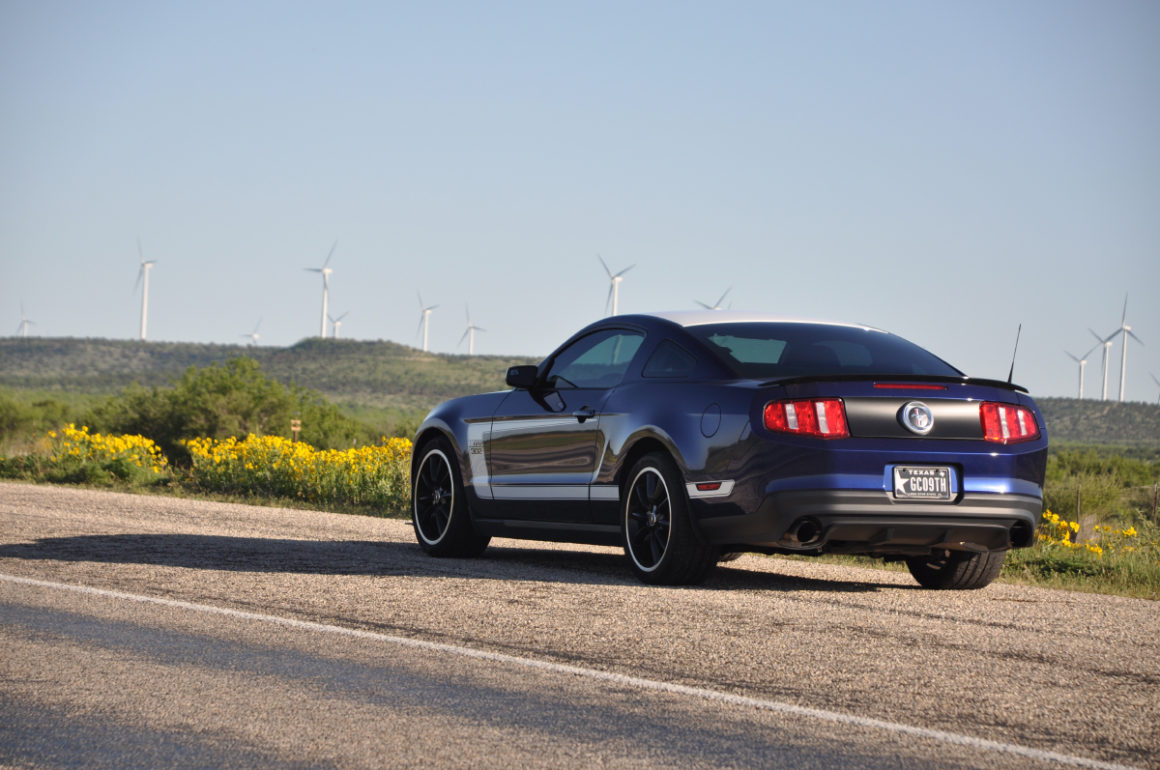
Still early in the morning, but almost out of Texas already.
By noon, I was in New Mexico. By 12:15pm, I was tired of New Mexico. No wonder they used to explode atomic bombs willy-nilly out there in the 1940’s – who would care or even notice? So much of that state is just miles of flat, empty desert. The desert can be beautiful, but generally not in the middle of the day. Roswell offered some visual relief, but I had no time to tarry and I was soon back on the road. I took US-285 out of Roswell with a little over half a tank of gas, thinking I would just refuel in the next town. After an hour of driving without seeing any civilization whatsoever, much less a filling station, I began to feel the first signs of range anxiety. My range was less than 100 miles and there was no sign of a town big enough to support a filling station. I would see signs for tiny little ghost towns, but the signs also indicated that there were “No Services.” I saw a sign for Albuquerque, but I knew I couldn’t make it. Was there anything out here? I was driving 20 mph under the speed limit with the windows rolled-up and the A/C off. Finally, I saw a sign for Vaughn and it looked like it was barely within range. Vaughn did have a filling station and I never felt so good about paying too much for gasoline. It occurred to me that the Boss might not be the best vehicle for a long-haul road trip off the interstate highway system.
I got back on US-285 and soon ran into I-40 heading west into Albuquerque. I was delighted to discover that for some distance, I-40 is the old Route 66! Well, it’s not the same asphalt, but at least it follows the same path.
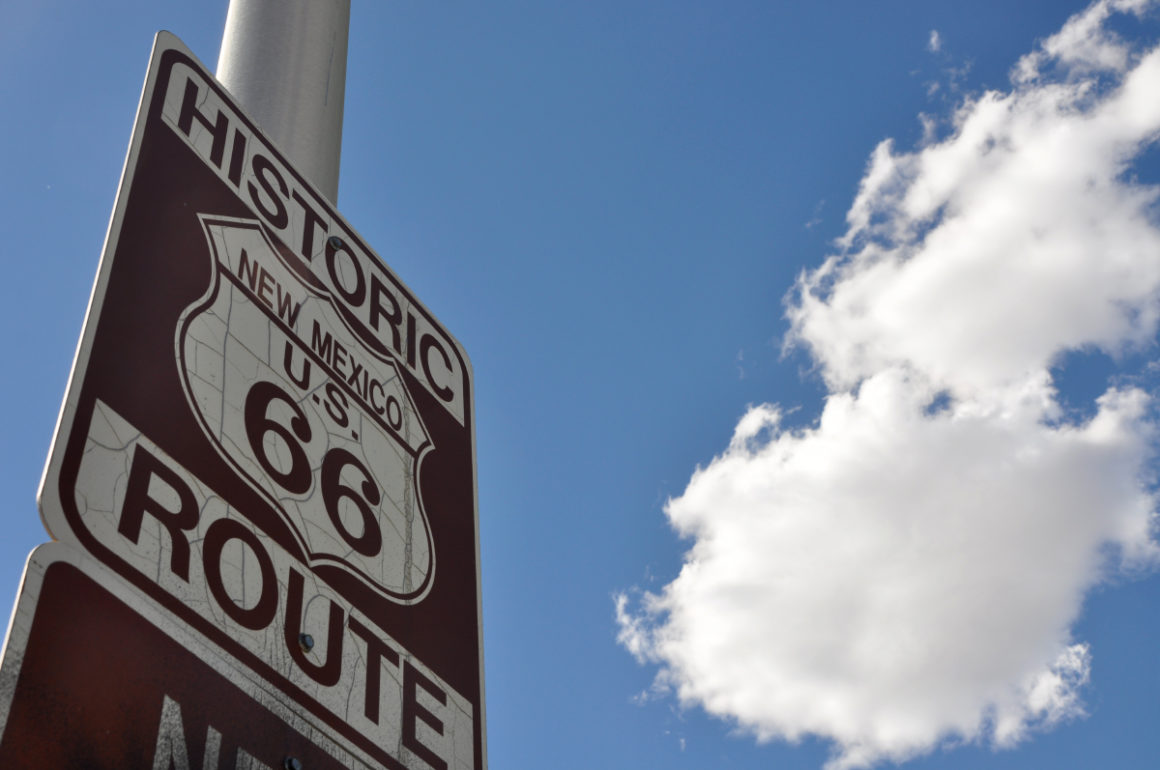
Historic Route 66 sign in Albuquerque.
Once I got outside of Albuquerque, I began to see hills, mesas, and mountains. The light was falling and the landscape was starting to look downright pretty. I’m sorry about what I said about you before, New Mexico.
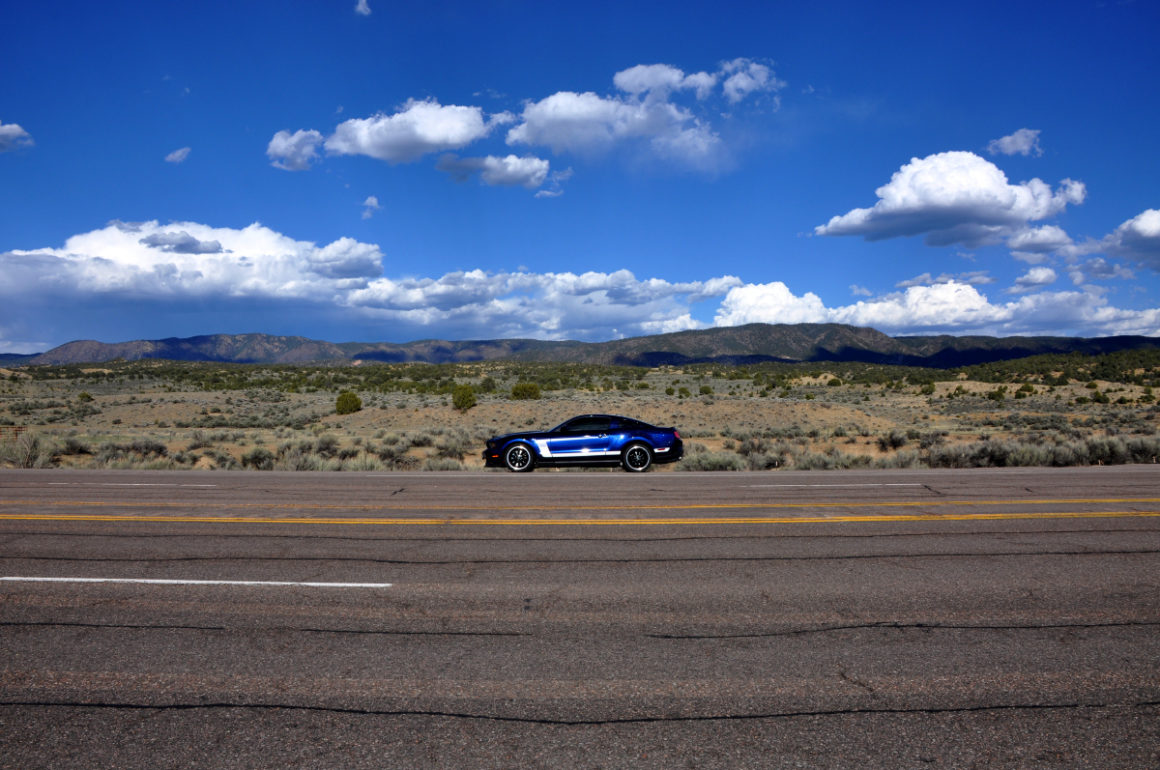
Somewhere in New Mexico.
I finally crossed into Colorado late in the evening and on a winding little two-lane back road. Night was falling and I was trying to get to Durango, where I planned to stop for the night. It was a good road and I was hustling to make good time, but this scene stopped me.
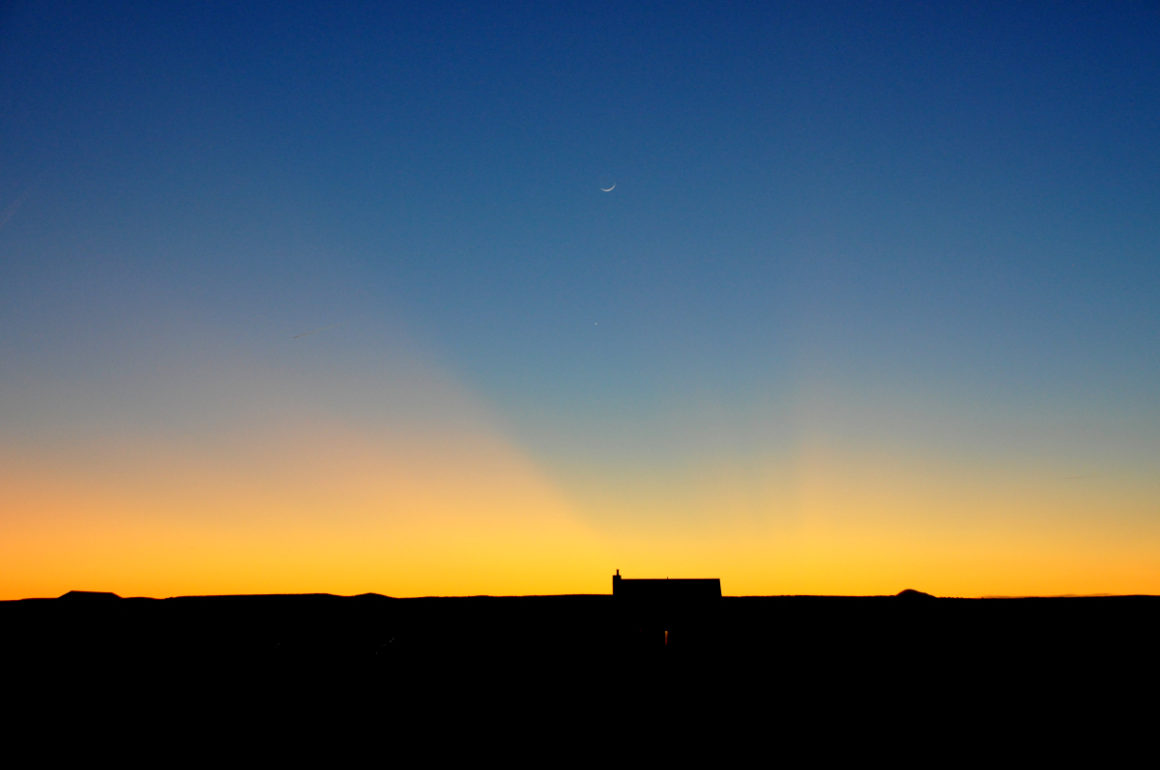
Two planets line-up over a lonely farmhouse, while the falling sunlight creates flame-like streaks in the sky. This was only the third time I had ever seen that phenomena. I enjoyed the reverie at the end of such a long day.
I finally stopped in Durango. It had been a tiring day, but I had made good time and I was on schedule to arrive in Salt Lake City, with plenty of time to spare before the reception dinner.
Monday: Utah and Miller Motorsports Park
I started early the next morning and finally got to see Colorado in the daylight. Oh, so this is what all the fuss is about.
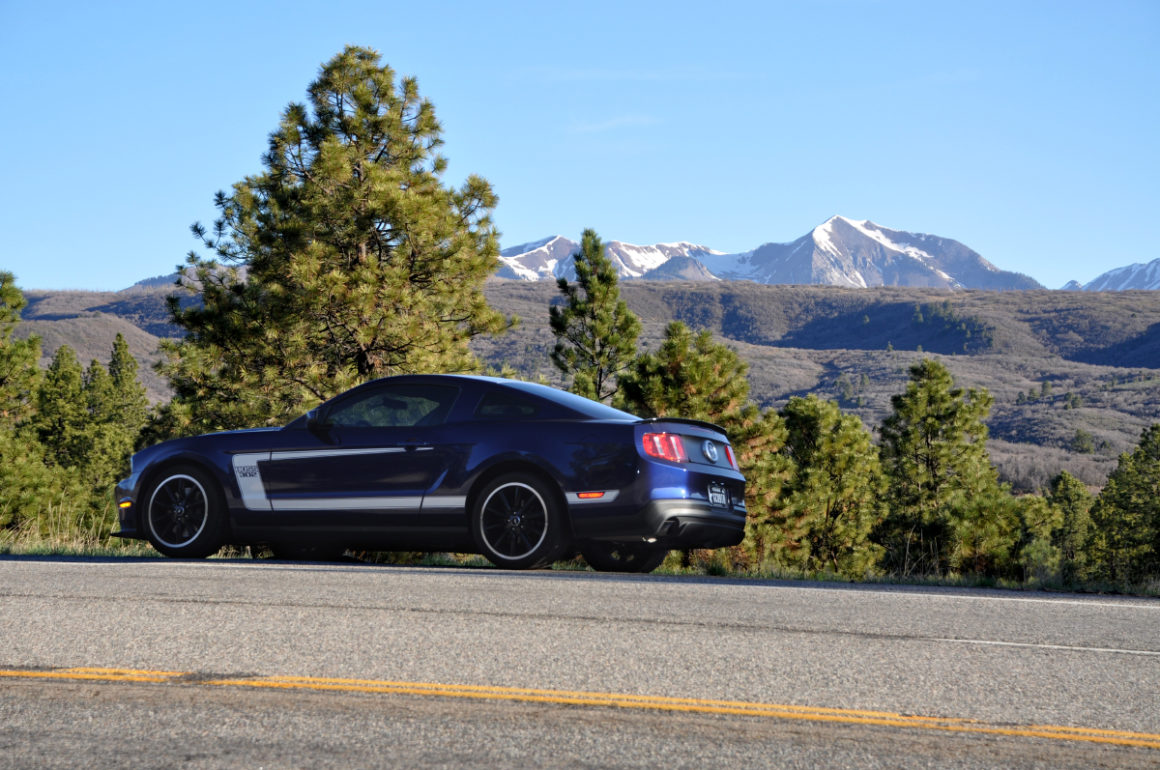
It was a lovely view, but I was only clipping the corner of Colorado and I wouldn’t be there for long. I stopped for a snap or two, but I was soon driving headlong into Utah. I had never been to Utah and…well, I hear a lot of strange things about that state. But whatever else it is, it is a beautiful place.
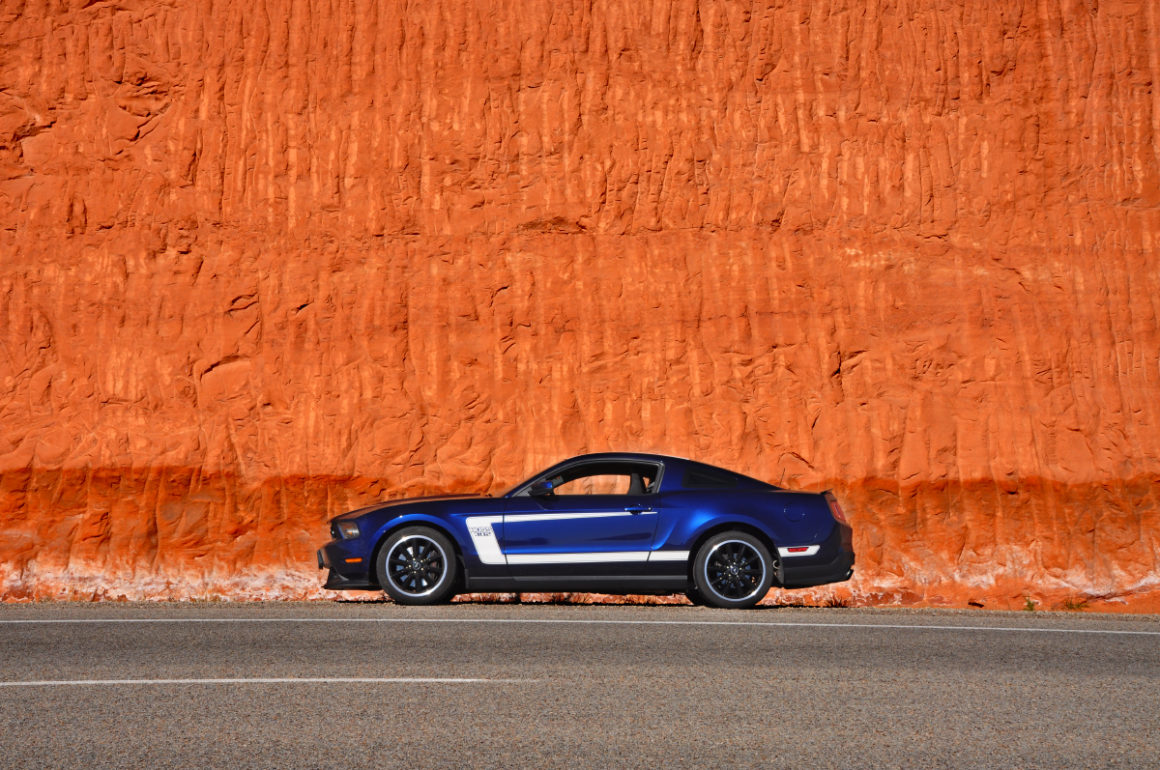
Somewhere in Utah.
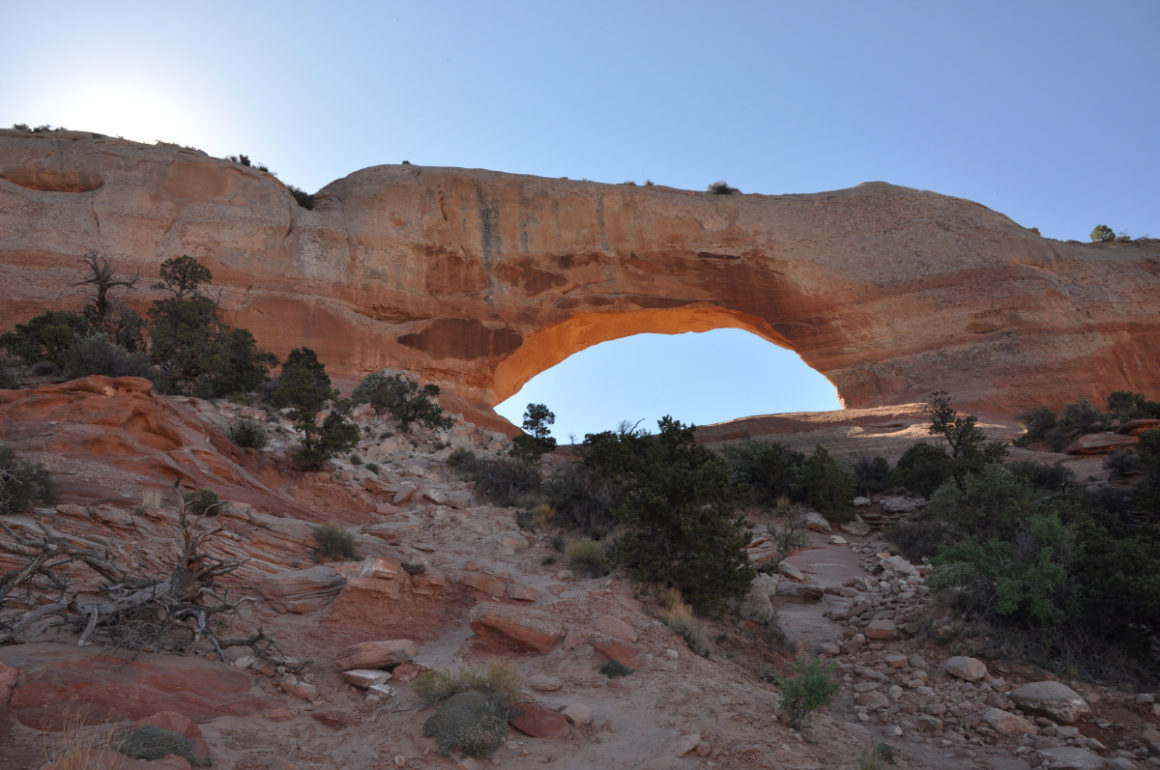
This is Wilson Arch. I still had a full day of driving ahead and I hadn’t planned to stop and do any kind of sightseeing, but this was right on the side of the road, so I stopped and ran to the top. It felt good to stretch my legs a bit and get my heart rate up, but I failed to accommodate the fact that I was out-of-shape and now at 7000 ft. above sea level. I live somewhere around 600 ft. above sea level, so that’s a problem. When I got back down to my car, I was out of breath and coughing like a madman. Then I started wheezing and realized that I hadn’t brought my Albuterol inhaler. Now I have done it, I thought. I’m going to die out here in the high desert. Who does that anymore? What is this – the 1840’s? What an idiot. It took a full half hour for my body to calm down. Top Tip: Be sure to stop and enjoy our national treasures, but don’t do stupid stuff.
The rest of the drive to Salt Lake City was a pleasure. Utah is a beautiful state and the excellent roads that wound through the countryside were a delight. I got to Salt Lake City in the afternoon and found my hotel. I unpacked, cleaned-up, and had a little rest before dinner.
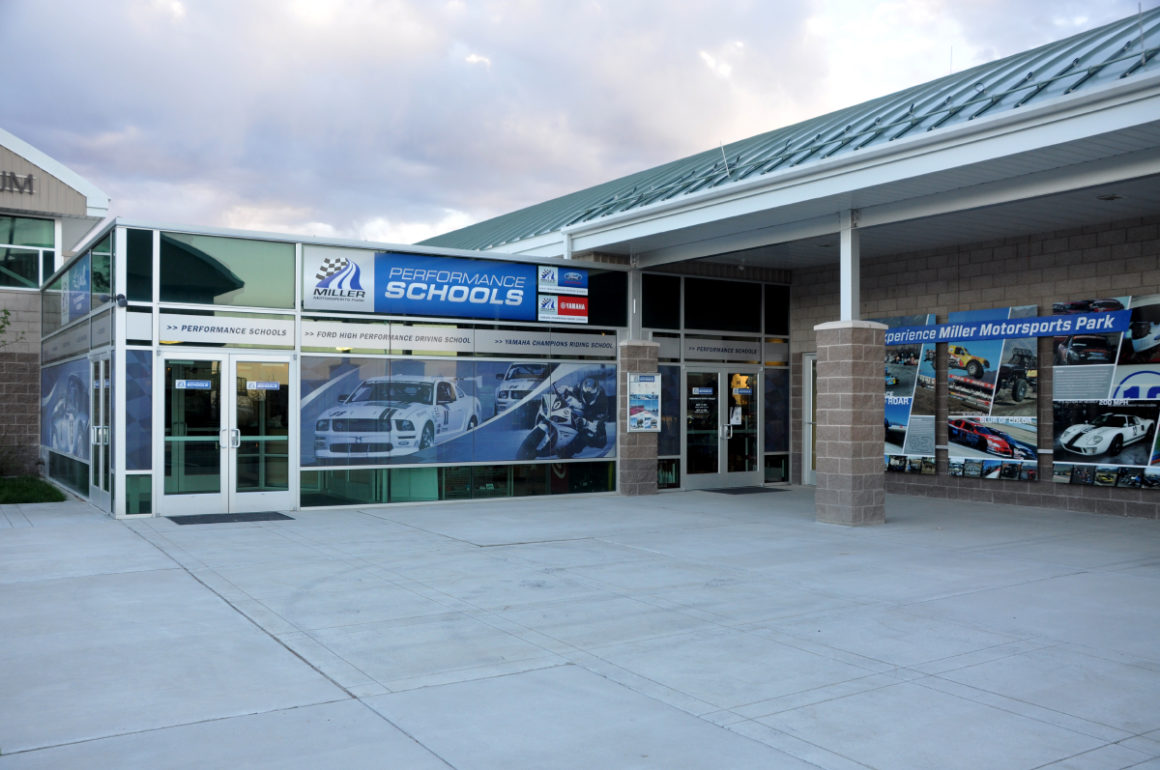
I arrived at Miller Motorsports Park just before 6pm for the reception dinner. The dinner was held in the museum, amidst millions of dollars worth of Mustangs, Cobras, and other beautiful machines from the late Larry Miller’s collection. I walked around and met some of the other guests. We were given plenty of time to look at the cars and memorabilia before dinner. After awhile, we were given a formal guided tour, which revealed interesting information about the cars in the collection.
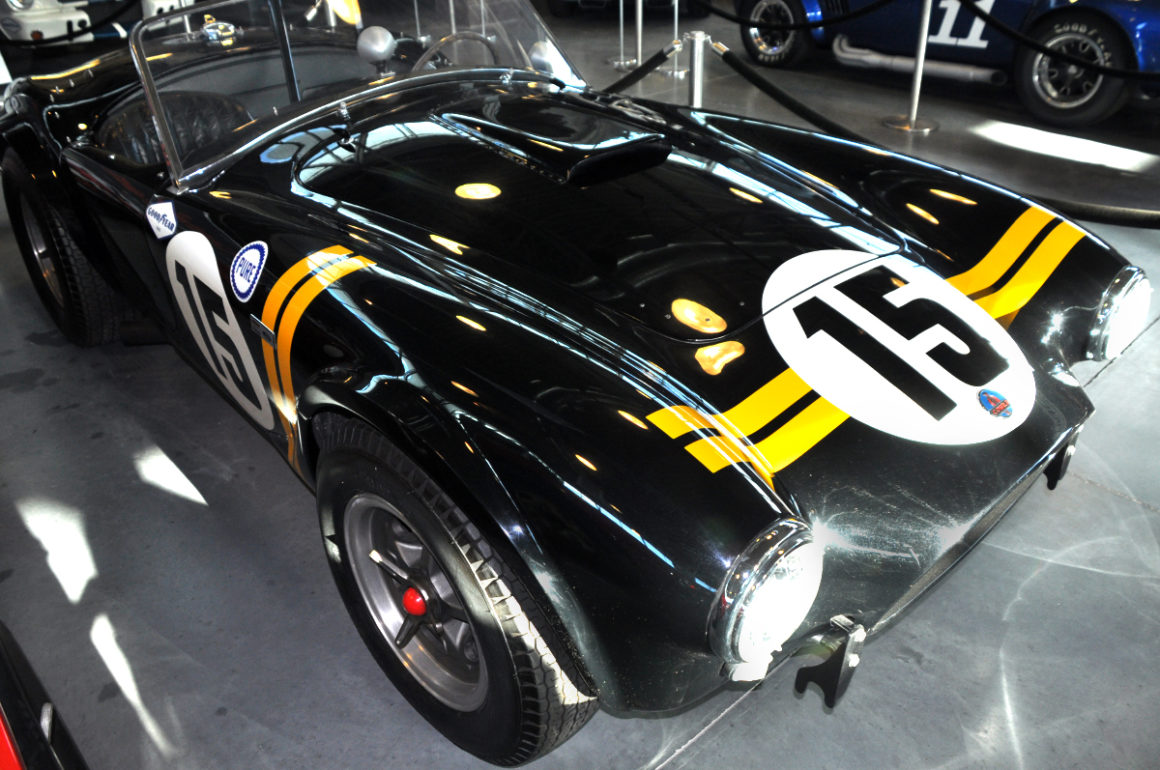
In 1964, this car was used on the cover of The Rip Chords’ album Hey Little Cobra. When Larry Miller tried to buy the car at auction, he expected to pay only around $200,000. However, the bidding was driven up by an unknown absentee telephone bidder. The price went to over two million dollars before Mr. Miller finally secured the car. The mysterious bidder on the other end of the telephone? George Lucas. Before he began making movies, Lucas had been a car enthusiast. Lucas designed the paint scheme of the car for his friend, racer Allen Grant, and for a time, served as the crew chief for Grant during his early racing career.
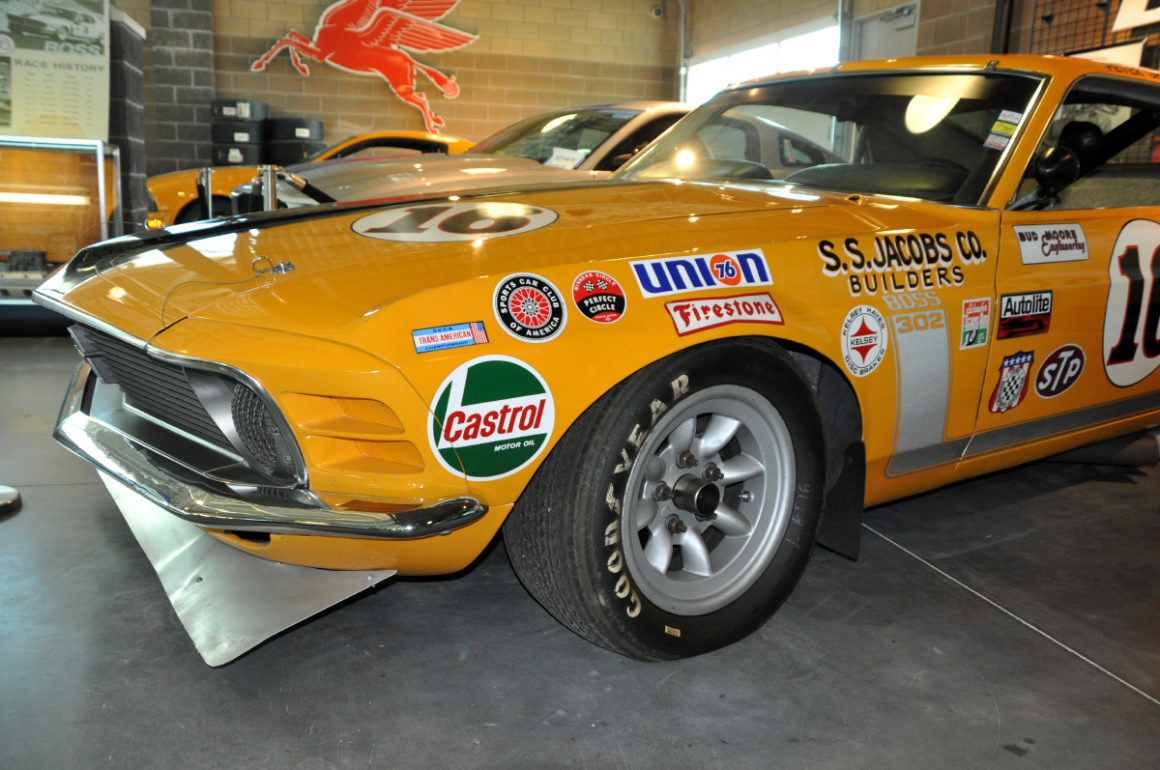
This 1970 Boss 302 racer is actually the only car in the museum that is on loan. Presumably, this was done for the benefit of the Boss Track Attack guests.
After the tour, we sat down with the nice dinner they provided for us. Cindi Lux, the head driving instructor, introduced herself and welcomed everyone to the Boss Track Attack. We watched a video about Track Attack and then Cindi sat down and talked about what we could expect the next day. We went around the room and introduced ourselves. I recognized a couple of folks from the Mustang forum that I now frequent. We talked about our cars and what kind of track experience we had. I was surprised how few had any previous track experience.
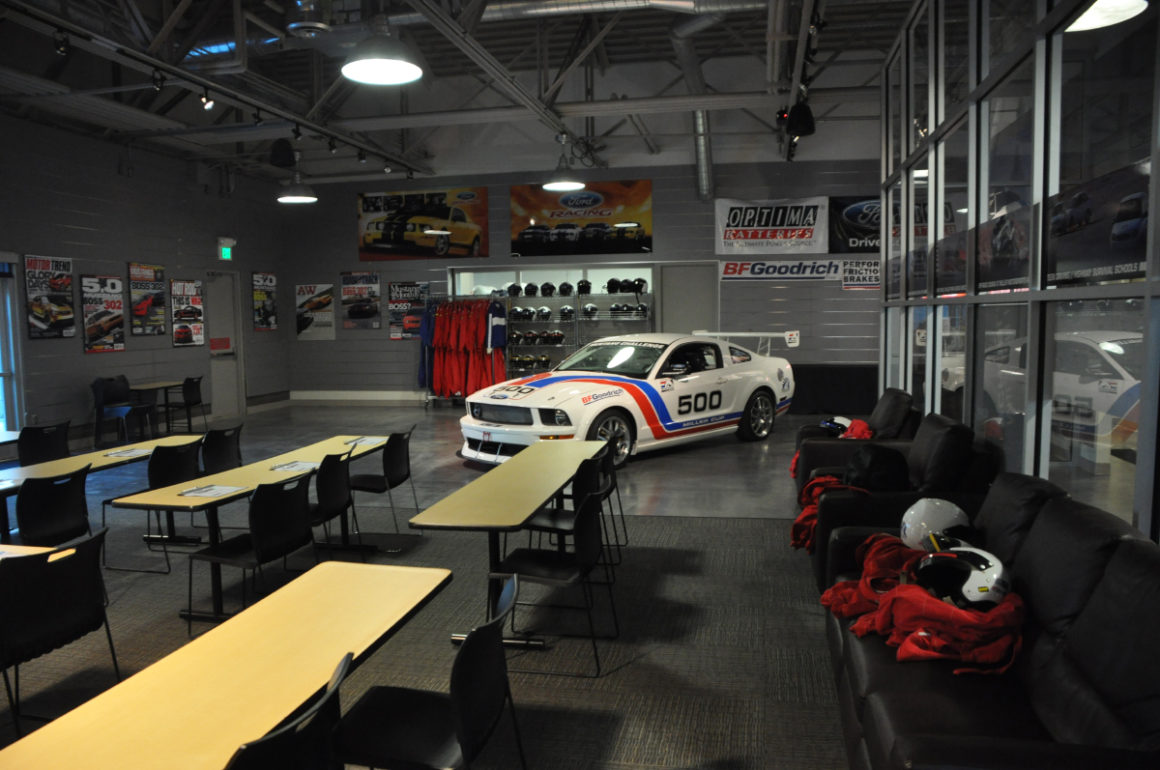
After dinner, I stuck my head into the classroom, which was right next to the museum entrance. Oh, yeah. You have to like a classroom with a racing car in it. I went back to the hotel and tried to sleep.
Tuesday: Boss Track Attack
I arrived bright and early Tuesday morning for the Boss Track Attack. Cindi began the first classroom session with a video of Ford executives addressing the students and explaining why Ford had decided to sponsor the Boss Track Attack. After the video, she jumped right into some basic driving concepts like understeer, oversteer, proper responses to those conditions, and the basic late-apex driving line. Then she introduced the other instructors for the day (Jon, Ronnie, Mark, and Bob). They handed out Nomex suits and helmets, and then we were off to get in the cars! The classroom is important, but I appreciated that there was never much time between track sessions.

We piled into a couple of vans and they drove us to the garage area. They told us to find our car, put our helmets on, and get strapped-in. I spotted the one and only Kona Blue Boss, but it was assigned to somebody else. I was a little disappointed, but was excited to see that at least I got a Laguna Seca (LS). I’m not sure what difference it makes, since all of Miller’s school cars are brought-up to LS specs. Each car gets the LS front splitter and rear spoiler, the LS brake cooling ducts, LS transmission cooling scoop, the 302S front grille, 302S front brakes, a bigger radiator, a roll cage, and safety harnesses. I don’t think the base cars get the LS gauges. They are nice, but I still hate the pod on the dash and I realized after the event that I never looked at them on track. Not even once.
For the first track session, we just played lead-and-follow with the instructors. They went slow and the idea was just to introduce us to the track for the first time. We would be driving the East Course for the day. As we drove around the track, I could see signs indicating the name of each corner: Fast, Faster, Gotcha, Agony, Ecstasy, Windup, Release, etc. We went around a couple of times and then went back for another classroom session.
By this time, they had split the class into smaller groups, so that they could rotate them through various exercises efficiently. It also allowed for better individual instruction. As it happened, I was in a group with only one other student.
After another classroom session tailored to the track, Instructor Bob took us back out and we walked various parts of the track. This was so that we could see subtle elevation changes and other topographical elements that aren’t necessarily apparent at speed.
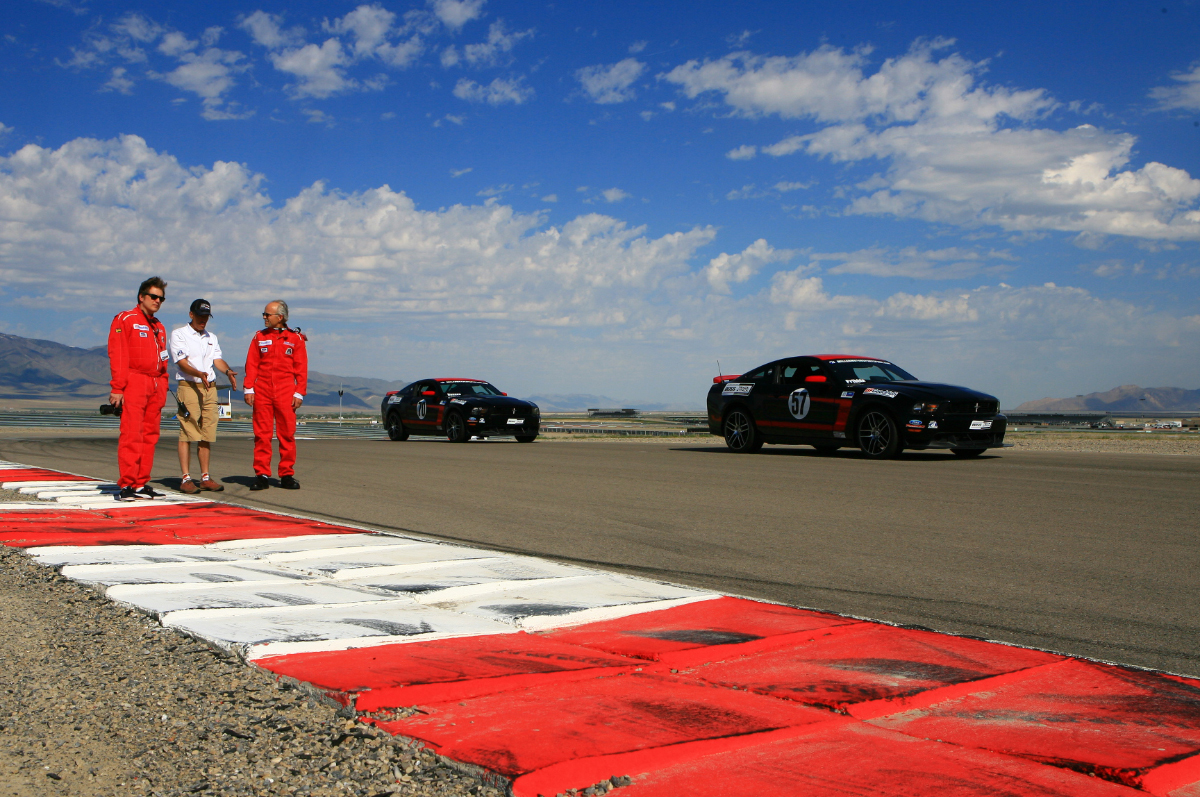
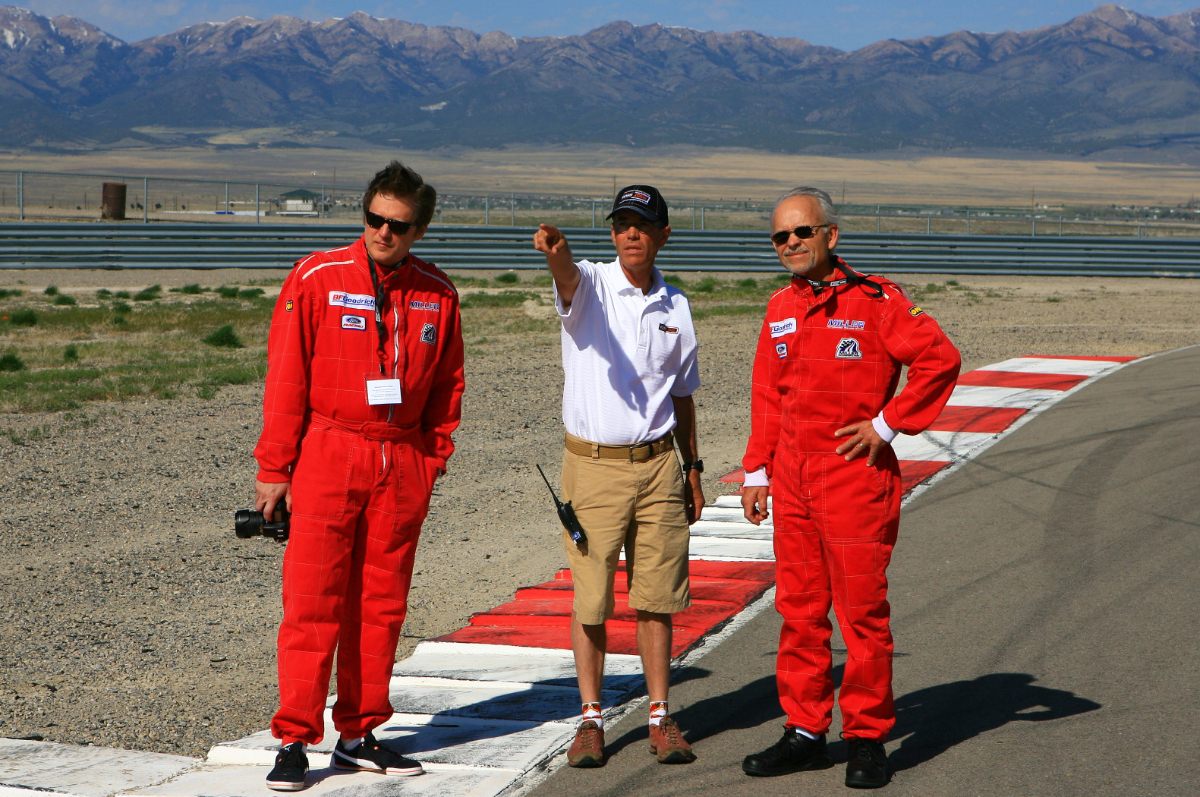

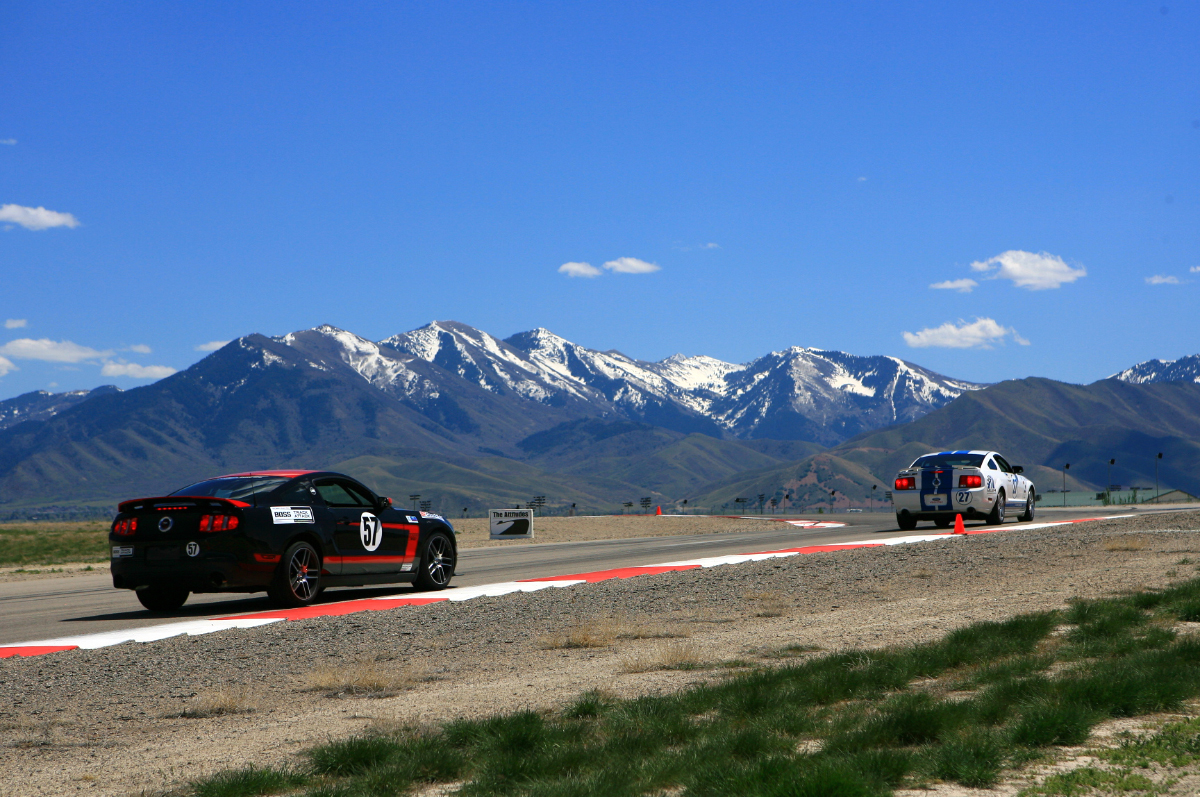
After the second track session, we went to the skid car exercise. The skid car is an ordinary Ford Five Hundred outfitted with a system that allows weight to be moved around the car to create low-traction in an otherwise safe environment. In other words, they can make the car feel like it is on ice when it isn’t. Even better, they can do this on the fly and can make the car understeer or oversteer. I jumped into the skid car and in less than 30 seconds, I had spun it ’round like a record, baby. After I had done this a couple of times, Instructor Robbie told me that I needed to shuffle steer. Wait, what? Since the first time I ever got on track, I had been taught to stick my hands at nine o’clock and three o’clock…and leave them there! In fact, to get caught doing otherwise on my racing team was a sure way to suffer endless humiliation and torment by the other drivers. But, while trying to control the skid car, my arms were getting crossed-up and I wasn’t turning the steering wheel fast enough.
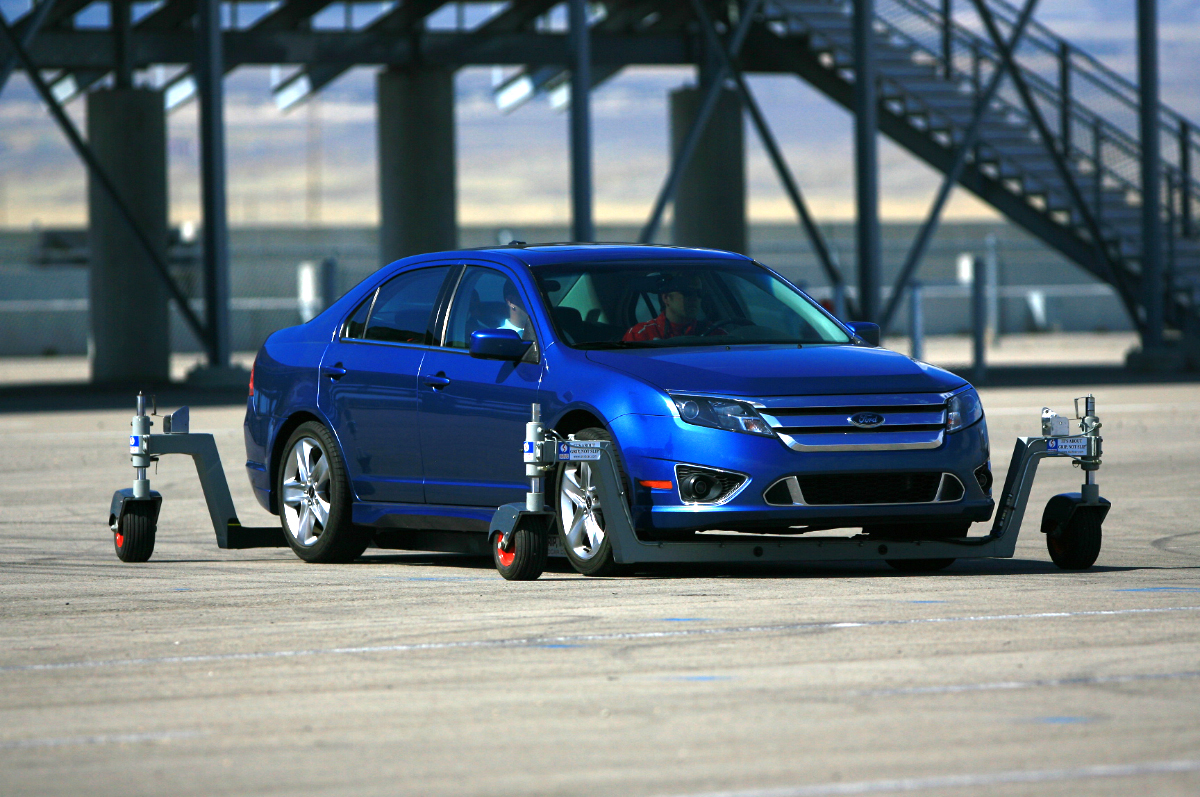
The skid car was easily one of the best parts of the day. It was mad fun and I learned more in that car than in any other part of the school. I could have driven that car all day long and felt like I still hadn’t mastered it. I wonder if we could make one?
After the skid car, we got back in our cars to do the heel-toe downshift exercise. Instructor Mark gave us some pointers and then set us loose on a triangle-shaped track where we got up to speed and then heel-toe downshifted from 4th to 3rd. I practice this on the street all the time, so I was practicing going from 4th to 3rd to 2nd. My technique was pretty good (though I still come off the brake just a little when going to blip the throttle), but Mark gave me some instruction about not downshifting at all until after most of the braking is done. I had been starting too early. We went round and round, stopping to get feedback from Mark each time we completed a circuit. After the heel-toe practice, Mark showed us how to use the pit speed limiter and I rumbled back to the garages at a perfect 35 mph, even though I had the accelerator pedal mashed to the floor. I’ll have to remember to activate that the next time I let a valet park my car.
We broke for lunch, which was again provided by the school. While we ate and rehydrated, Mark reviewed what we had learned that morning and prepared us for the afternoon, where we would finally see some open track time.
After lunch, we piled into a van and Mark took us around the track and reminded us about the details of the correct driving line and why we should adhere to it. A few times he took a corner in the loaded van at speed, which I think was a bit terrifying for some of the passengers. When we got back to the garage, the class split into two big groups and for the rest of the afternoon, we alternated track and classroom sessions.

The next track session was a no-passing lead-follow with the student driving and the instructor in the passenger seat giving a check-ride. Instructor Jon rode along with me. After the first lap, he said, “Stop that.”
“What?” I asked.
“Why are you turning-in so late and getting on the gas so early?” he asked.
“I’m a quattro driver. Maybe that has something to do with it?”
He gave me some pointers and then got out of the car after two laps and said to go have fun. He said I clearly knew my way around the track. Later, in the classroom, he drew some driving lines on the whiteboard and showed me what I was doing in the corners. He said that it was very typical for drivers of “cheaty” AWD vehicles, but that a powerful RWD car needed a different driving style.
The last track session of the day was just the students (unless an individual wanted an instructor) and we could go as fast or as slow as we wanted. Passing was allowed on the front straight with a point-by from the lead car. We lined-up single file and Mark sent us out on track one at a time by showing us how to use the launch control feature. I pressed the launch control button, mashed the go pedal down, the revs locked at 3000 RPM, I came off the clutch and shot onto the track!
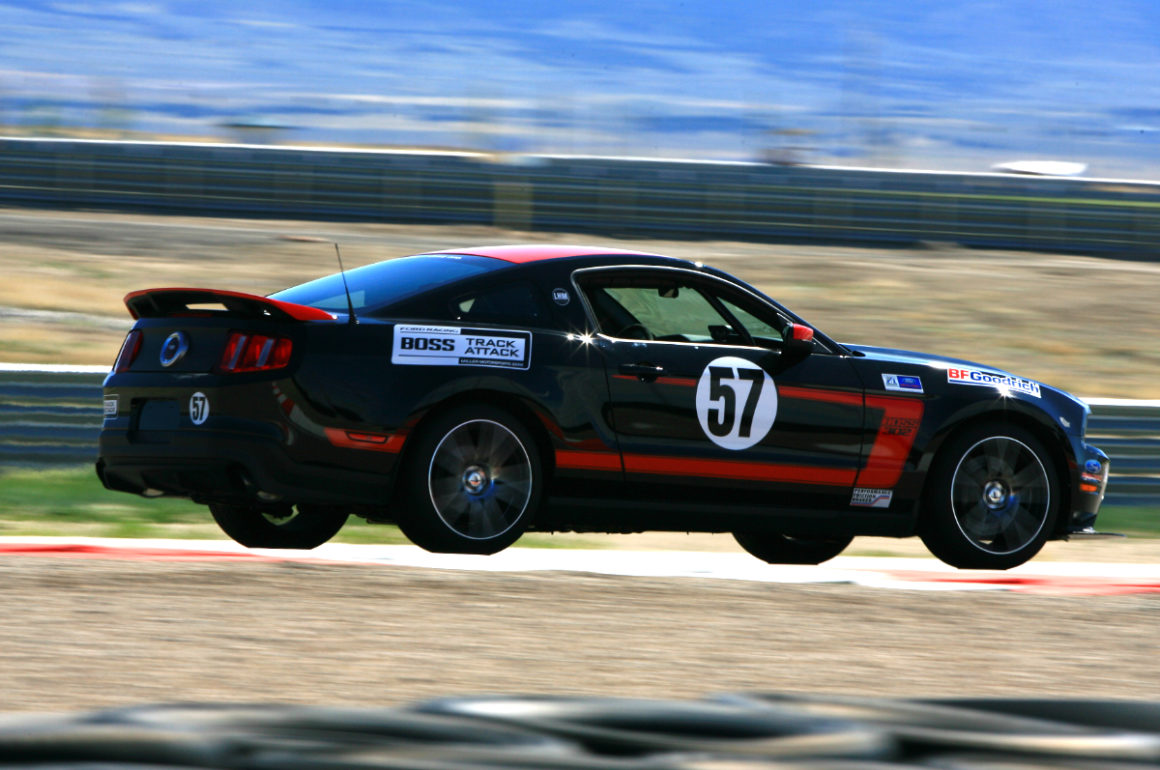
This would be our one free track session, so I gave it the beans. With better brakes and stickier tires than my street car, the Boss LS really came alive on the track. It was easy to drive, but I was still wary of fully committing to the throttle mid-corner. More track experience will help me with that. Still, I was reasonably quick and I was having mad fun. I got held-up by a student which allowed the Hackleman brothers, a couple of fast guys from Louisiana, to catch up to me. Chris was directly behind me in another Boss LS and Paul was behind him in a regular school Mustang.

The school Mustang’s are track-prepped, but down a whopping 125 hp compared to the Boss, so Paul was doing all he could to stay in the game. Once we got around the slow student, I played fox to Chris’ hound and we were off and running. I overdrove the car a couple of times and found myself with four wheels on the red and white gator-strips that line the corners. But the Boss just absorbed the bumps and I pressed-on. After a couple of laps, I thought I would give Chris an open track to see if he could get away from me. I signaled for him to pass on the front straight, but they threw the checkered flag and the session was over.
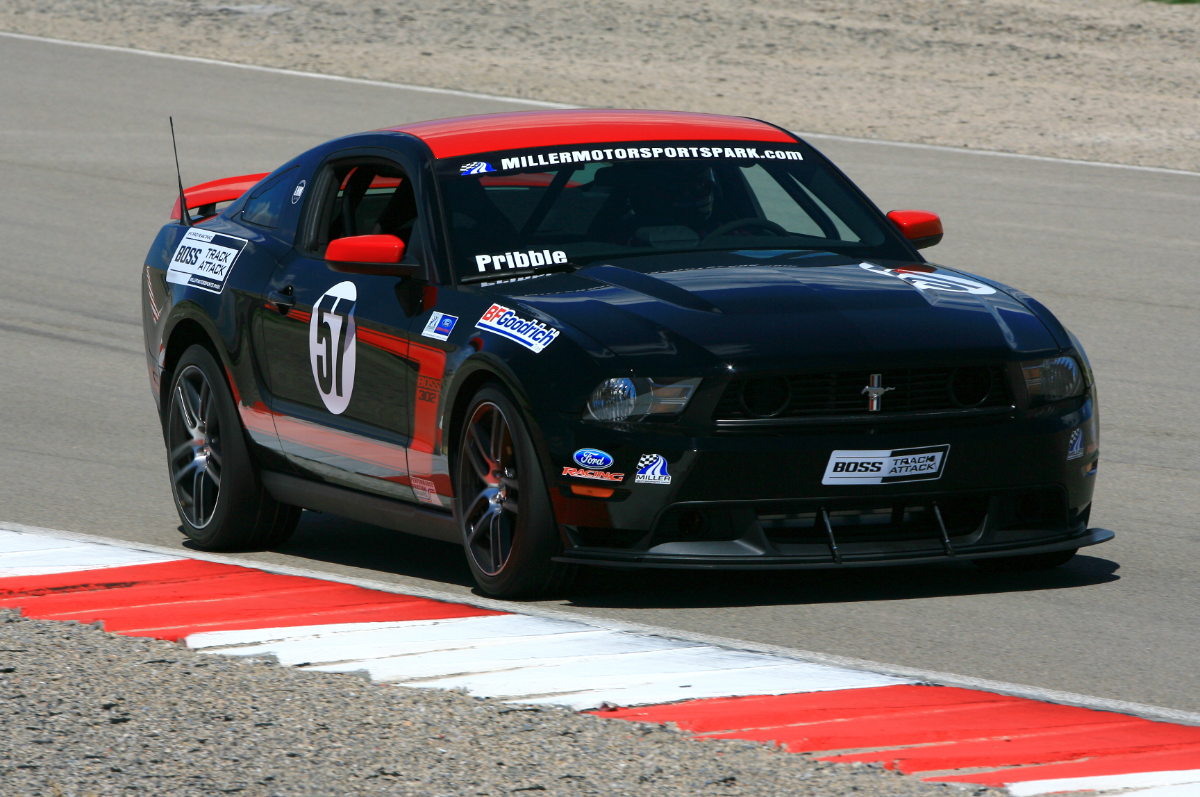
As a treat (or “payback”, depending on whom you asked), the students were given a couple of laps around the track with an instructor driving. I sat in the passenger seat of my car and a skinny kid named Michael introduced himself and slipped behind the wheel. He couldn’t have been more than 19 years old. He was very friendly and we lined-up to get on track. Once he saw the track was clear, he punched it. We started with the corner combination Fast, Faster, and Gotcha. Michael, who clearly drives on some other plane as myself, took the corners by going faster, fasterer, and still fastererer. He didn’t scare me, he just left me not understanding how he was getting the car to do what it was doing. I hadn’t felt that way since the first time I went to the track and my instructor, Don Istook, took me for some fast laps in my car. Coming out of The Attitudes, Michael got the car bent out of shape while we were going flat-out onto the back straight. We got into a violent tank-slapper and I just knew we were off. Here we go, both feet in. But somehow, he saved it. Again, I couldn’t figure-out how he did it. I saw him move the wheel back-and-forth and jab the throttle a couple of times, but I just couldn’t keep up with what he was doing. We took a couple of laps and pulled-in. I was buzzing.
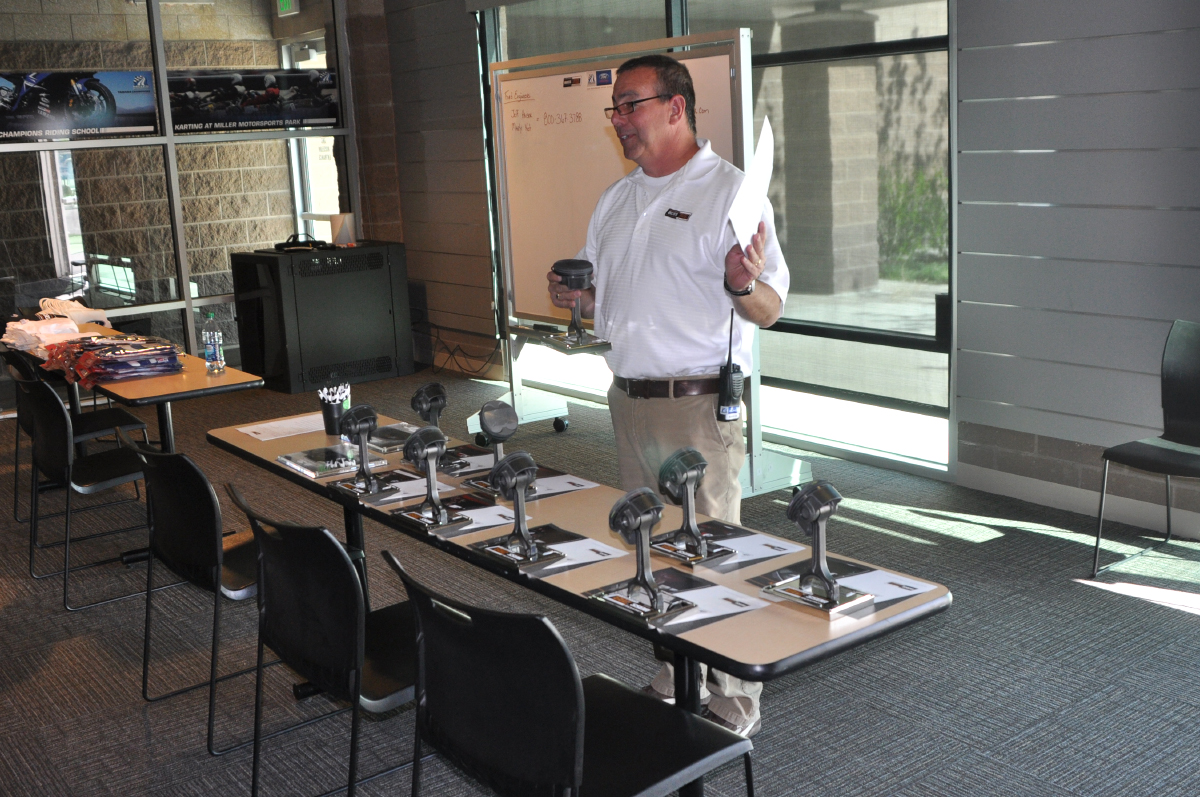
We went back to the main school building and were presented with our trophies, which are made from Boss pistons and connecting rods. So cool. We also got a Boss Track Attack t-shirt, a pair of racing gloves, and a thumb drive with 400 photos that a professional photographer had taken during the day. I thanked all of the instructors and then told Cindi that I planned on watching the World Challenge race over the weekend. She excused herself for a moment and then came back with a free pass for me to attend the event!
That gesture from Cindi sums-up the generous attitude of everyone I met that was associated with Miller and Boss Track Attack. The program itself was beyond my expectations. It was executed with the highest level of professionalism by instructors who were always helpful and friendly. The facility and track is world class. The break-out groups were small enough to allow for a some individual instruction. They never dumbed-down the concepts, even when addressing novices. This made the lessons palatable by experienced drivers, who I believe can always benefit from occasionally reviewing the fundamentals. The instructors were always encouraging and they would frequently remind us that we were there to have fun. In the end, it was the attention to detail that made it. Nothing felt thrown together. The catering was spot-on. All classroom and track materials were provided. Drinks were provided. The program kept a strict clock and there was no chance that we wouldn’t get to do something we were promised we would do. Receiving a Certificate of Completion was not unexpected, but a trophy made out of a Boss piston? Racing gloves? A thumb drive with 400 professional photos of your day? The Boss Track Attack program and the folks from Miller Motorsports Park and the Ford Racing High Performance Driving School were so good, that I don’t feel like I can adequately convey how impressed they left me. Probably best to just say – thank you.

When I have the scratch, I am determined to return to Miller and attend their four-day race licensing school.
Wednesday: Bonneville Salt Flats
On Wednesday, I drove west on I80 towards another temple of speed – the Bonneville Salt Flats. Since the 1930’s, the Salt Flats have been the home of the landspeed record, their vast, flat expanse (some 46 sq. miles) allowing even rocket cars to stretch their legs.
The Salt Flats are a barren expanse of hard packed salt crust, but surface conditions are variable and not always ideal. The salt crust is several feet thick in some area but tapers off to just a few inches thick towards the edges. Underneath the salt crust is mud. From November to May, cooler weather slows evaporation of the flooded lake bed, sometimes leaving the surface a salty slush. Don’t skip ahead, this is important information. In the 1840’s, The Donner Party suffered their tragic fate, in part, because their wagons wheels became mired in the mud found below the salt crust, which delayed their travel into the Sierra Nevada mountains until the deadly winter was already underway. Now, what is it they say about those that don’t know history are doomed to repeat it?
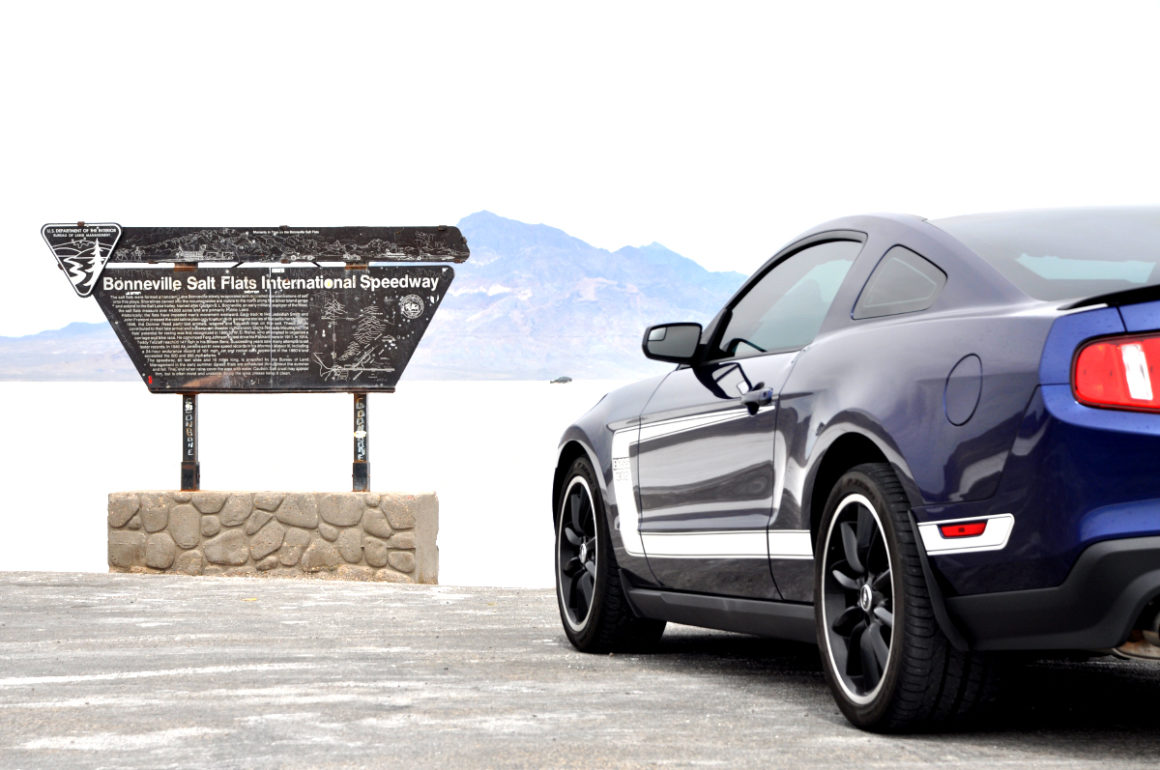
I arrived at the cul-de-sac at the edge of the salt flats and from the road I could see a car out on the salt. At first, I thought somebody was just doing what I was about to do. But the car wasn’t moving and even from a distance, it appeared as though the front end was sitting too low. A blown tire?
I drove out onto the salt and made my way towards the car, but as I got closer, I could see there was nobody in the car. The area seemed slushy and slick, so I turned away and drove further out onto the flats where it felt more solid. The flats are, well…flat, but they aren’t perfectly smooth. There are ruts and ridges from rainwater. I wondered how the car would handle those at speed. During sanctioned events, the course is prepared with a sled, which smoothes the driving surface.
After driving for awhile, I stopped to take some photos of the car. The salt flats afford a beautiful, surreal, and photogenic landscape. Lighting is obviously bright and uniform.
I took a towel and tried to wipe down the car of the salt that had kicked-up on the drive out. That’s when I realized how nasty this stuff was. I brushed the salt on the rocker panels and nothing happened. It was solidly encrusted on the body of the car. In fact, the whole surface of the car was covered in a thin layer of salt. I ran my hand across the body and it felt like sandpaper. After driving through the slush near the road, I couldn’t imagine what the undercarriage looked like. The salt sticks to everything like glue. Corrosive glue. Weaponized salt. I needed to get off this crap and find a car wash.
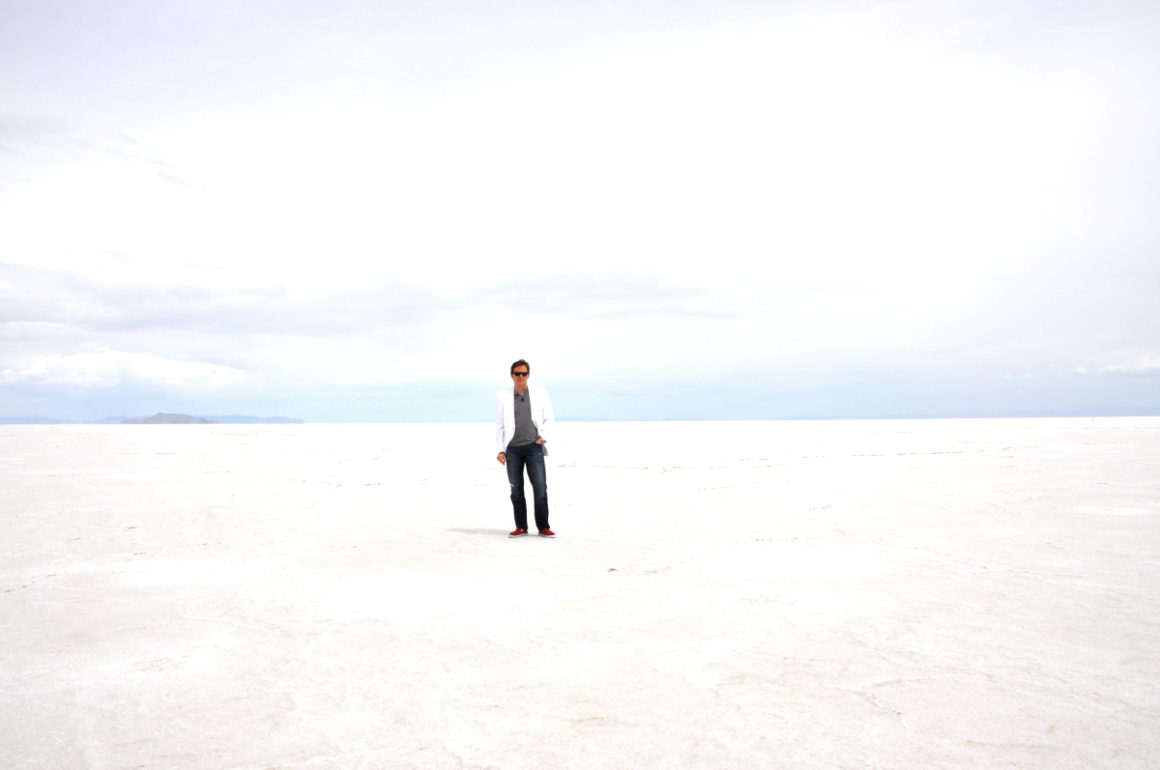
I spent about half an hour taking photos and then I packed away my gear. I drove further into the flats to accomplish my other goal – a top speed run in the Boss.
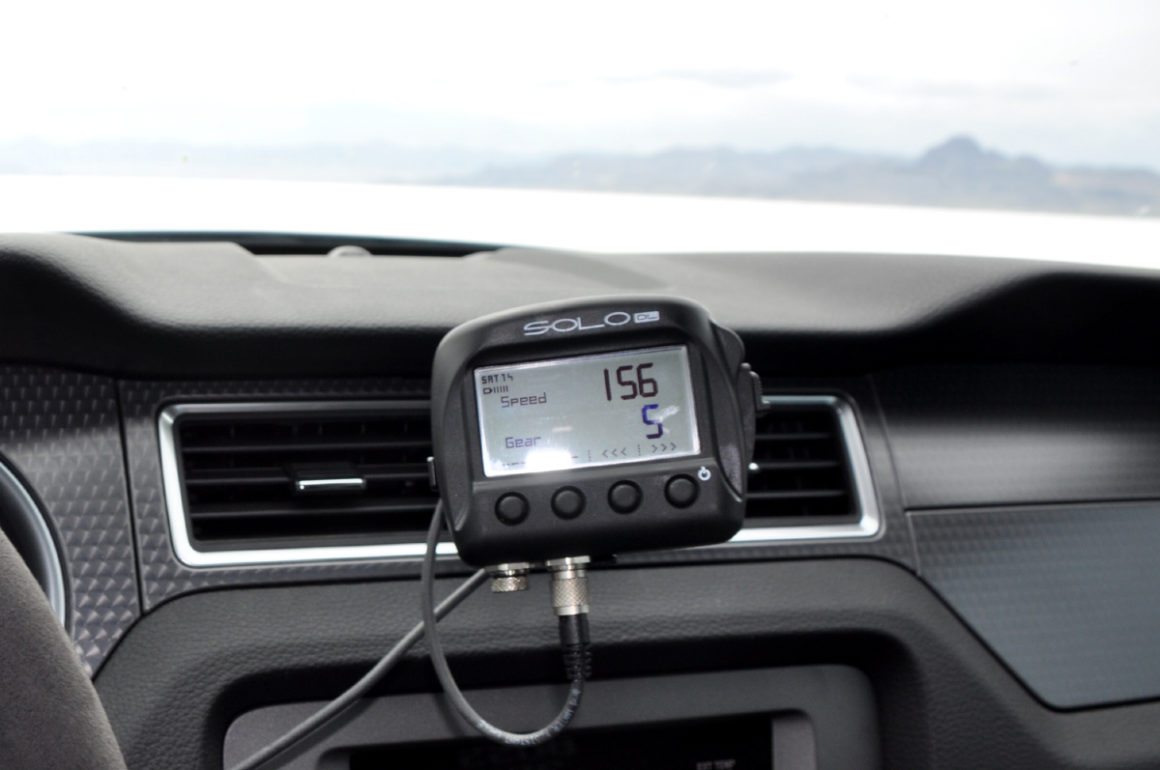
The Boss is electronically speed limited, so I already knew the answer to the perennial question “what’ll she do?” But, I wanted to see it for myself and I wanted to do it at Bonneville. It was part of the pilgrimage, it was correct, it was safe(ish), it was legal. I had already taken the Boss to 135 mph on a public road secret test track in Mexico, so I knew that it would reach terminal velocity quickly. Still, I gave myself a good long stretch of salt. After driving awhile, I started to see the flags that mark the official course. I hadn’t realized that they left them up year round.
I finally turned the car around and lined-up along the flags so that I could see them extending into the distance. I set the Solo DL to record the run and checked my camera. Even when dry, the salt crust creates traction problems, so I accelerated slowly through the first two gears, even short-shifting lazily. In third gear, I started to push on it. Then I shifted to fourth and fully committed to the throttle. It was a strange sensation. The car was making its glorious noise, long moments screaming at the top of her rev range, but outside, not much appeared to be happening. The blinding white salt lost every bit of detail, looking just like pure light and not providing any visual indication of speed. The mountains in the distance did not appear to be getting any closer. Only the occasional course flag flying by in a flash let me know that I wasn’t in some kind of simulator. The ride was rough, but not so much that I needed to back off. Hell, I was driving with one hand. I shifted into fifth. It was so loud at the end, I could barely hear the car hitting the limiter. I took a couple of photos and then the car lurched and I let off the gas.
The Solo DL indicated 156 mph. It was the fastest I had ever been in a car. I checked the data when I got home and I had gone 156.8 mph at 7493 rpm in 5th gear. I would love to see what the Boss could do without a speed limiter. She still has another gear!
When I got back to the road, I parked and watched a team unload Volvo’s Mean Green hybrid diesel truck from it’s trailer and take it onto the salt for a photo shoot. As it happens, this is the world’s fastest truck. Even though the truck holds the FIA records for the standing 500-meter, standing kilometer, and flying kilometer, it was in Utah to attempt to break its own records. The truck now boasts 2100 hp, almost 5000 torques, and improved aerodynamics. Good luck crazy Swedes.
After they finished their photo shoot, I walked out to the immobile car that I had seen out on the salt.
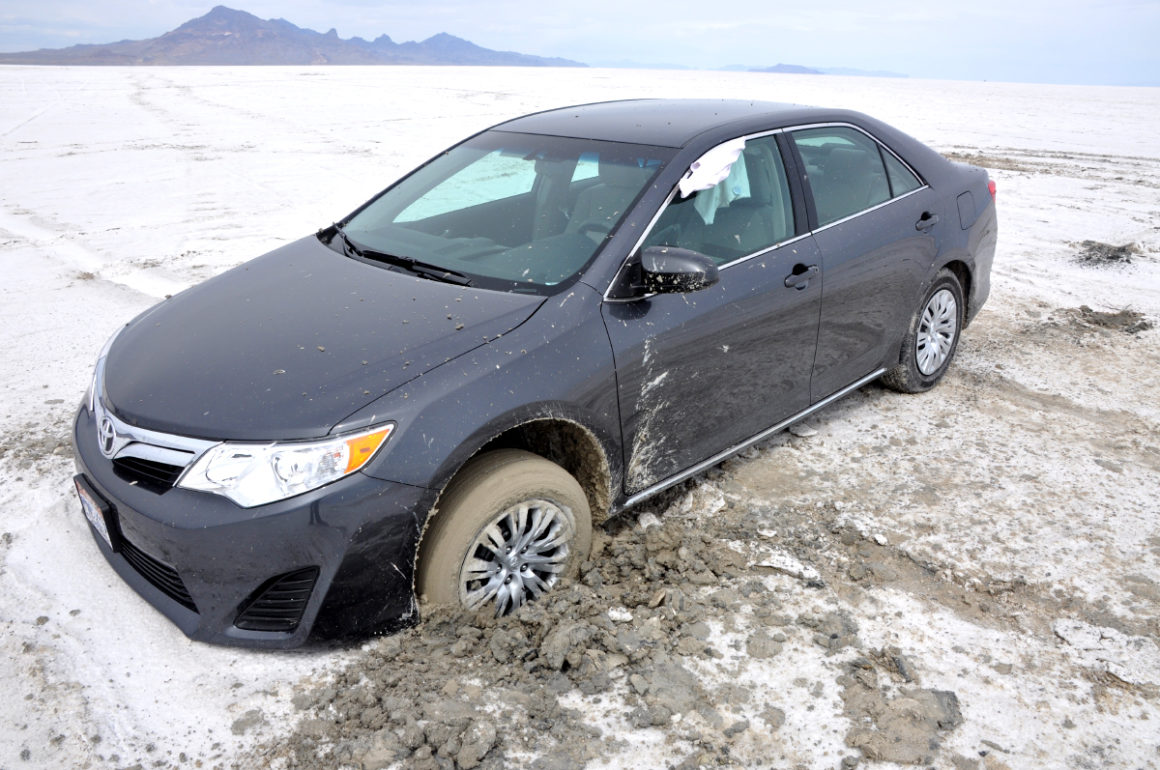
The tire marks told the tale. It looks like they were doing fwd donuts when they broke through the salt and into the underlying mud. The driver tried to power out, but only dug the car into the mud all the way to the body. There was evidence of a rescue attempt, but at some point they abandoned the car.
I drove back to the hotel, but not before stopping at a car wash and washing the car twice.
Thursday: Rest and a Mustang Cobra II
On Thursday, I stayed in the hotel all day and tried to get some rest. I love hotels. I find their comfort a decadent treat. Also, I don’t have a TV, so it’s always a pleasure to fire-up, in this case, a 52″ LG LCD and watch some shows.
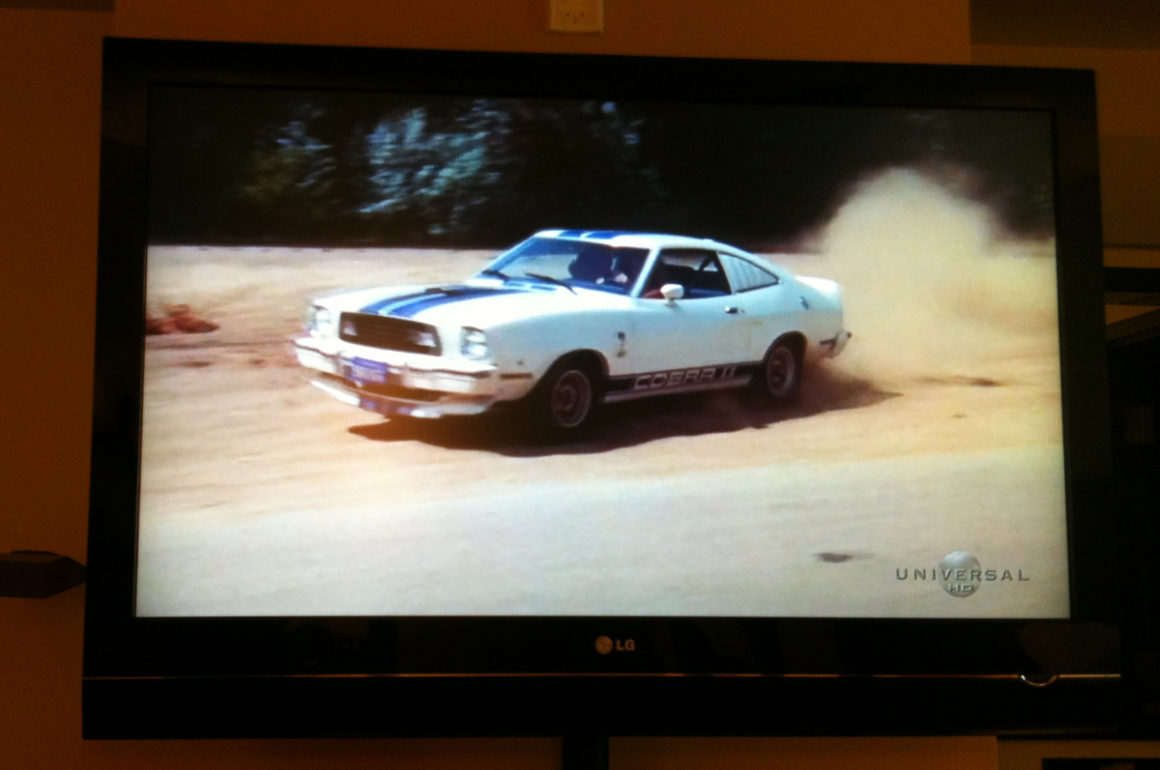
I thought I would be a bad boy and look at the hotel’s adult channel, but all they had was Charlie’s Angels. Stupid Utah. Anyway, I watched a couple of episodes, which featured the Mustang Cobra II. Somehow, perhaps the worst Mustang in history had snuck into my awesome Mustang Week. Still, it was quite fun watching Charlie’s Angels. Of course it is a terrible show in every obvious way, but if you look carefully, there is some goodness there. The show was made in the 70’s, which means that many of the cars driving around in the background are from the 60’s. I had fun just spotting cool cars that we never see anymore. I watched one episode in which Timothy Dalton plays a roguish gentleman thief that Charlie calls “James Bondian.” A few years later, Timothy Dalton would be James Bond! Anyway, in the show, he drove a beautiful and rare Porsche Carrera 3.0.
I stayed in all day, got some rest, worked on my blog, watched about a thousand episodes of Law & Order (there is always one playing on cable somewhere), and went to bed.
Friday: World Challenge Practice and Qualifying
I arrived at the track on Friday and immediately set-out to find the Boss race cars. Luckily the three cars were right next to each other.

First up was Paul Brown’s championship-winning and current championship-leading Boss 302S clone. I walked around taking photos of everything I could inside and outside of the car. Maybe more than actually watching the race, I was here to see how they had built these cars. The crew was very nice about it. After awhile, I moved to the #26 Boss 302S of Capaldi Racing. Again, I walked around taking photos and the team was very nice about me being underfoot. Then I walked over to the Motorsport Development Group’s #16 Boss 302R. The smurf blue Boss is driven by Alec Udell, who is only 16 years old!
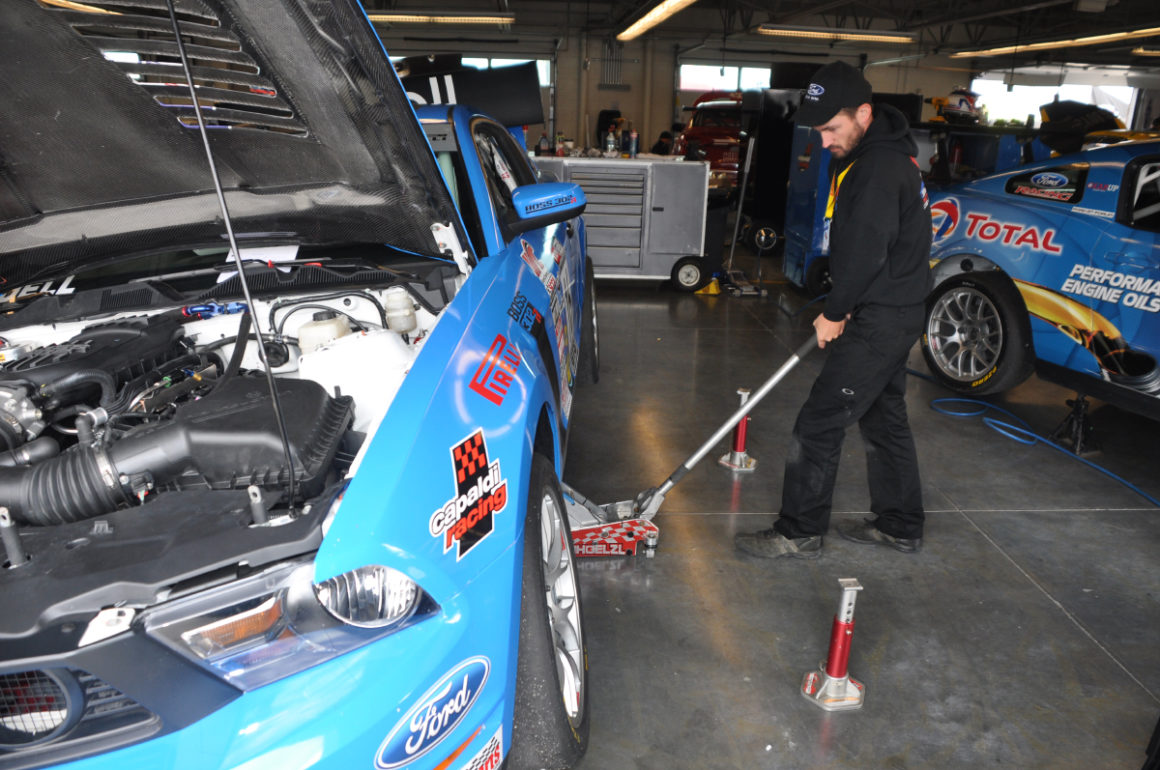
Matt prepares the car for practice.
For whatever reason, maybe because they were from Texas, I really took to this team. The crew, Cody and Matt, were exceptionally nice to me and let me ask them every dumb question about the car that I could think of. Bob Udell introduced himself and then walked me around and introduced me to his son Alec, Stuart Robinson of Motorsports Development Group, and Mark Wilson, the Engineering Manager of Ford Racing. These guys could not have been more friendly. So, I pretty much parked myself in their garage all day and just had fun watching the team operate. I am the captain of an amateur endurance racing team and I found it fascinating to compare and contrast the differences (and similarities!) of our two teams.
One similarity that all race teams share is having to deal with the politics of the sanctioning body. I have certainly tasted bitter lemonade. This is especially true in a series with different cars that have to be artificially adjusted in order to keep the field competitive. This is how Kias(!) can be competitive racing against Mustangs and Camaros. The Mustangs have to use an inlet restrictor to bring their power down. But at high altitudes, where the thinner air already reduces their power, the restriction is too great. This doesn’t apply to turbocharged cars, like the Kia, because they don’t suffer at high altitudes and the team felt like the Mustangs wouldn’t be able to keep up. They appealed to SCCA, but their appeal was rejected.
That was the least of their worries. By the end of practice and qualifying, the MDG 302R had lost a cylinder and the Capaldi 302S was completely down and out.

The Capaldi Racing Boss 302S comes in on flatbed. Forum guys who complain about the factory splitter being too flexible might want to take a close look at this photo. Bending is better than breaking. And yes, I watched it flex.

Mark Wilson looked under the car and said, “That’s cute.” This is what he saw. That hole isn’t supposed to be there.
In the end, the Capaldi team threw in the towel on their own car, but would help the MDG team swap-in an engine from a stock Boss 302 that had recently been delivered to Miller to become a school car. Matt asked me if I wanted to help. I told him I was all in. I went and got my work jacket from my car and we got busy.
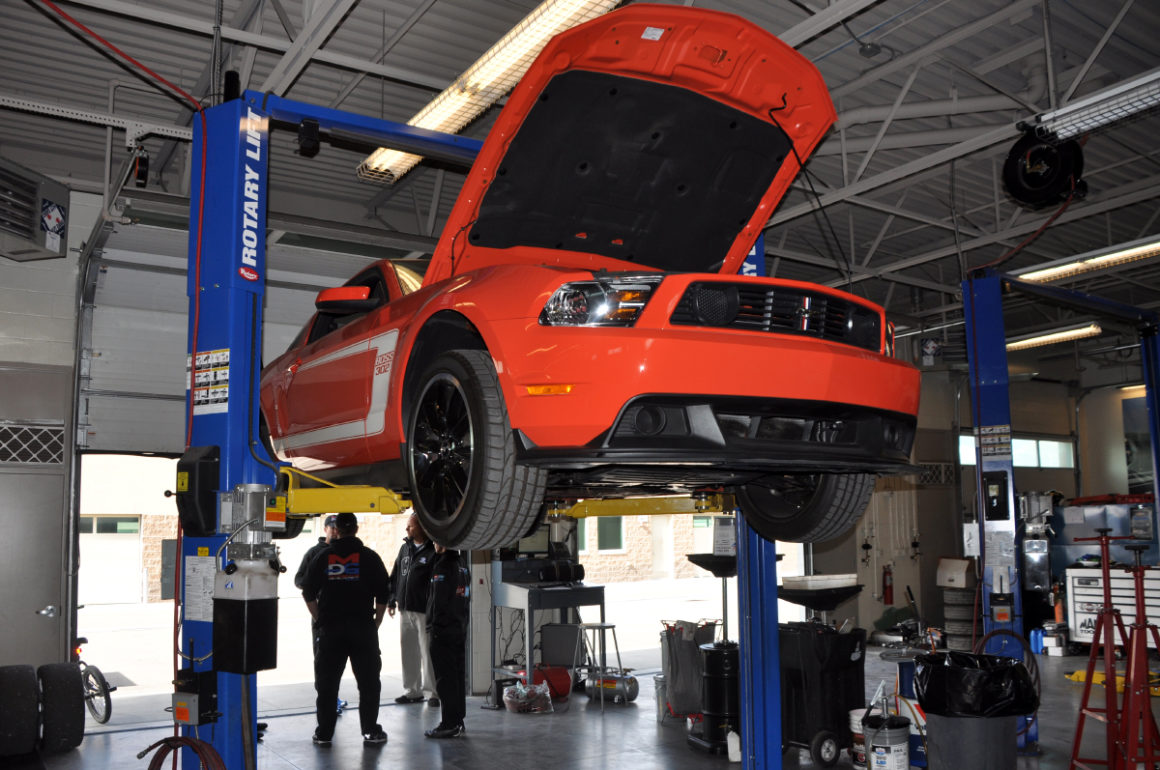
The beautiful new donor car – MP0002.
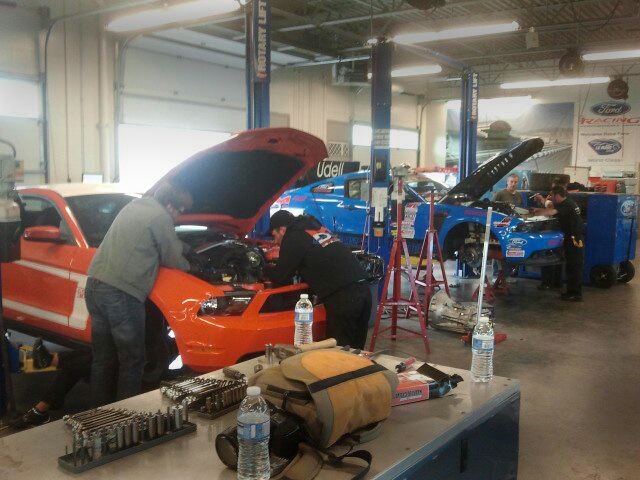
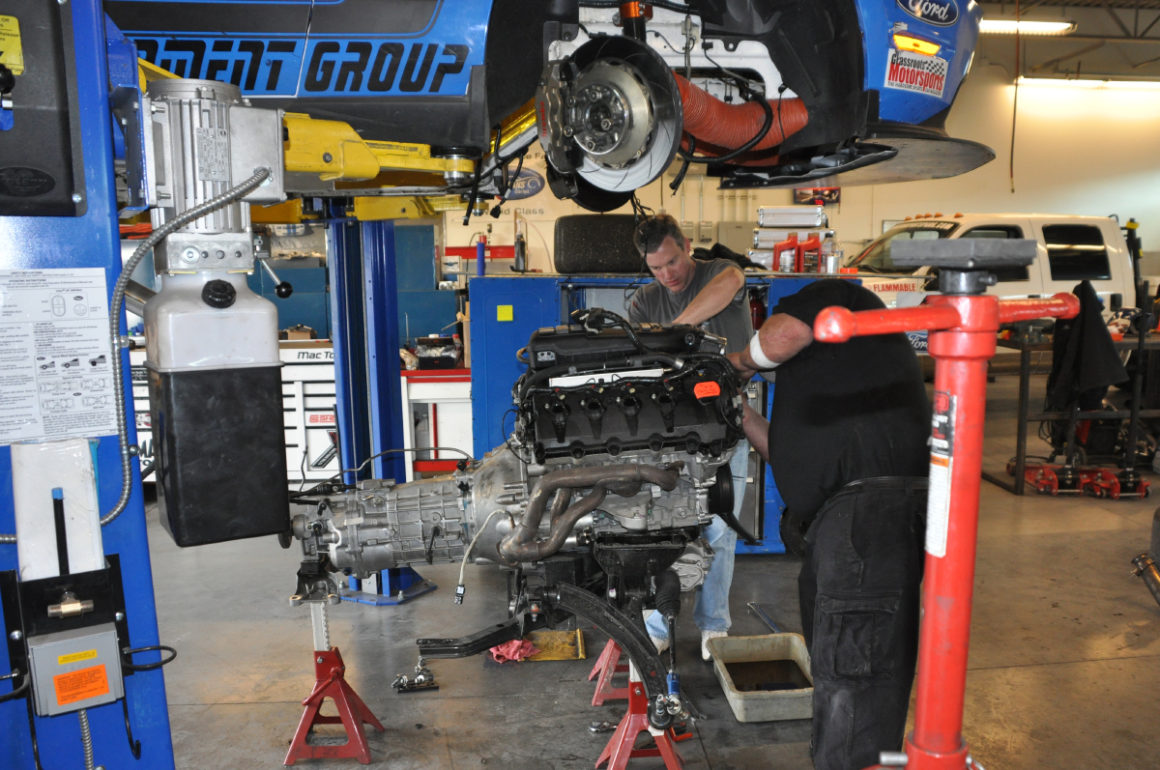
Mark Wilson begins the investigation for his Morbidity and Mortality Report. He would eventually find a broken valve spring. Team 302R pulled their engine more quickly, because race car!
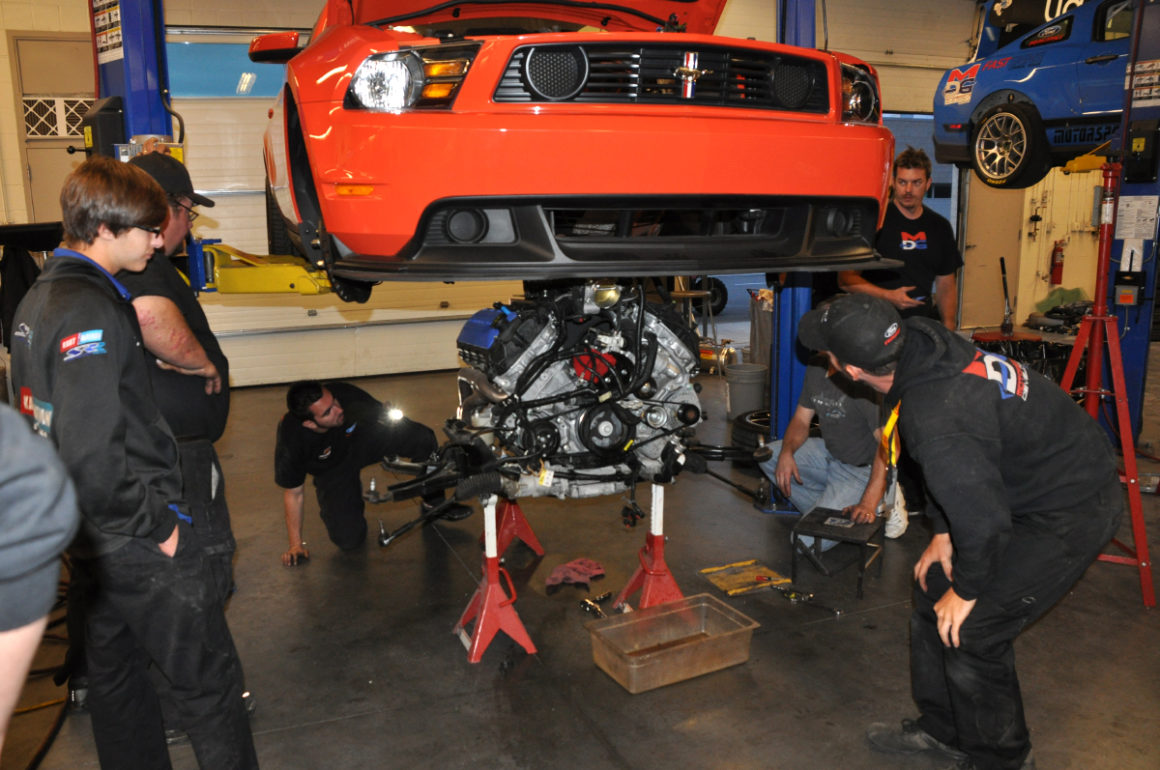
Finally, it’s out.
It took a couple of more hours to get the engine into the car. The race cars may use stock engines, but they use the transmissions from the GT500. So that had to be changed, too. Once we got the engine up and into the car, we called it a night. The team would finish everything else in the morning. They gave me a ride out to my car and I got back to the the hotel around 1am.
Saturday: Race Day!
I slept-in the next morning, but the real team was up early to complete the engine swap. By the time I got to the track, the job was done and everyone was enjoying breakfast.

Sandie Capaldi making omelets (to order!) for the hungry Boss teams. Later in the afternoon, she made us fresh smoothies. She’s a saint.
Race Day seemed less hectic than the day before, so I walked around the paddock and found my friend Don Istook, who was competing against the Bosses in the GTS class with his brand new Audi TT RS. Don had been my very first performance driving instructor and we had been active in the Audi community for years. He hadn’t had much time to develop the new car (he had previously campaigned a TT S), so there were some issues. Even though he had StopTechs all around, he felt like the brakes needed to be sorted a bit better. A more troubling issue was that he couldn’t turn-off the traction control, which was preventing him from powering out of corners like he needed. He was also on a fully stock suspension. It’s a neat little car and I’m looking forward to when he gets it dialed-in. I wished him good luck.
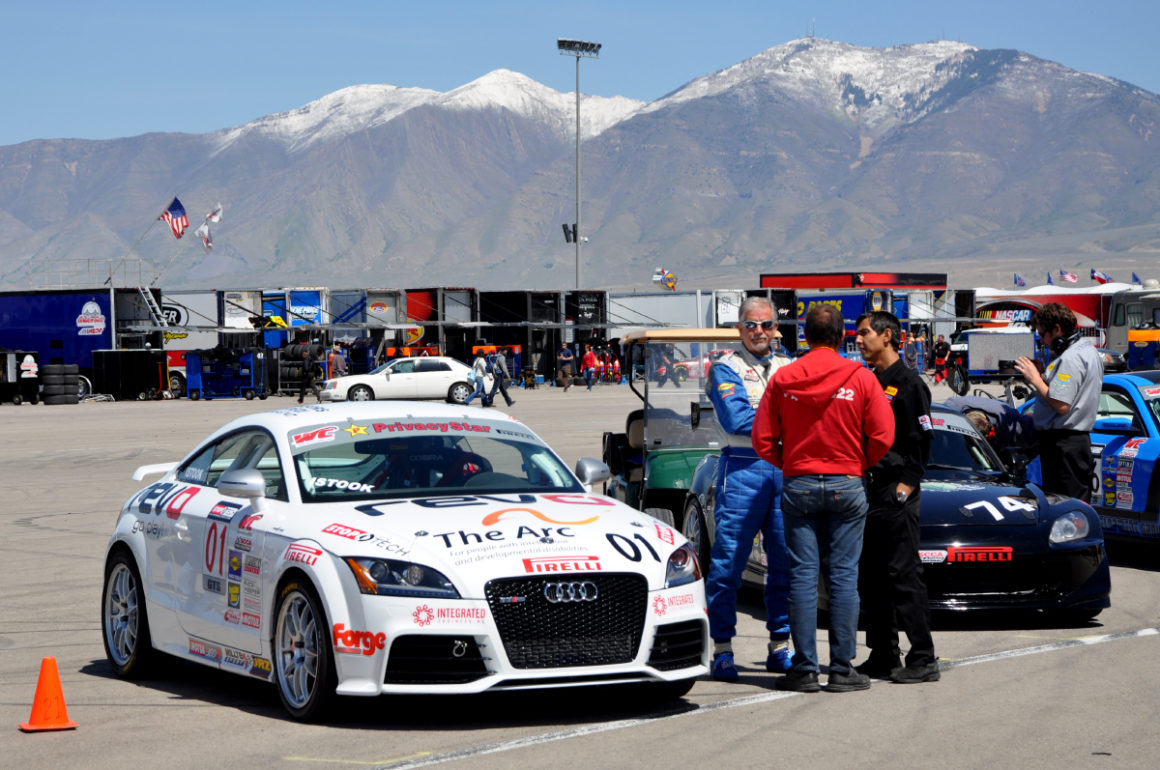
Don Istook and his Audi TT RS.
After lunch, Mark and I walked down and watched the cars stage for the race. Mark stopped and chatted with all of the Mustang and Boss drivers. While we standing there, a Cadillac CTS-V race car drove past us to stage. I apologized to Mark in advance for the heresy, but then told him that I thought the Cadillac was the best sounding race car I had ever heard. Period. I had heard the first generation race cars at Sebring, back in 2007 and they sounded the same way. They make a deep, guttural thumping that I could feel in the ground and in my chest. I don’t care which engine is in there, the Corvettes don’t make that sound, and neither do the Camaros. Mark agreed.
Finally, the cars went to grid and I staked out some turf at the end of the front straight. I couldn’t see all of the track, but Turn 1 was good to see high speeds, awesome braking power, and maybe a little action in the corner, too.
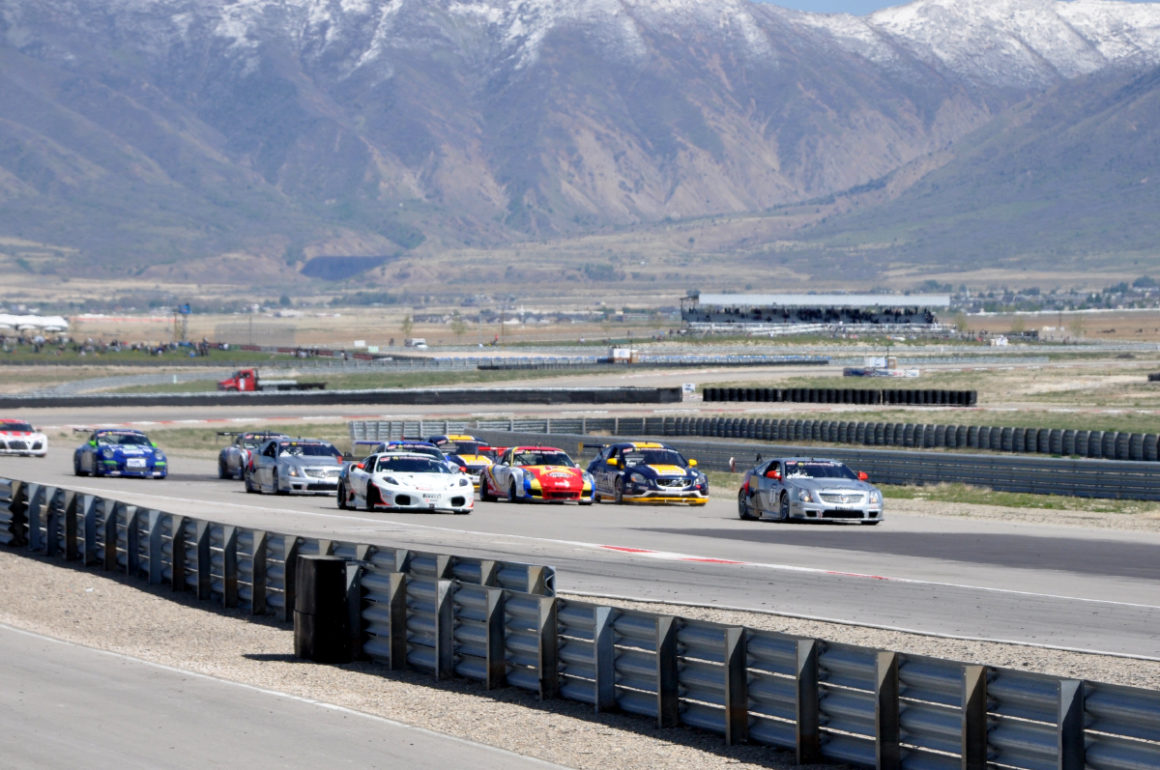
The flag dropped, the lights went out, and the race was underway! A Volvo went into the dirt to make a pass at the start, but despite the maneuvering for position, everyone made it through the first corner. The GT cars are shockingly fast and the works cars (Cadillac, Volvo) can brake very late from the high speeds of the front straight. It was a beautiful thing to watch. Still, despite the works cars and their unobtainium kit, there was an ordinary Porsche that eventually made it out front. The Cadillacs were in the hunt, but the Volvos suffered reliability issues, one of them finally having to be towed back behind the wall.
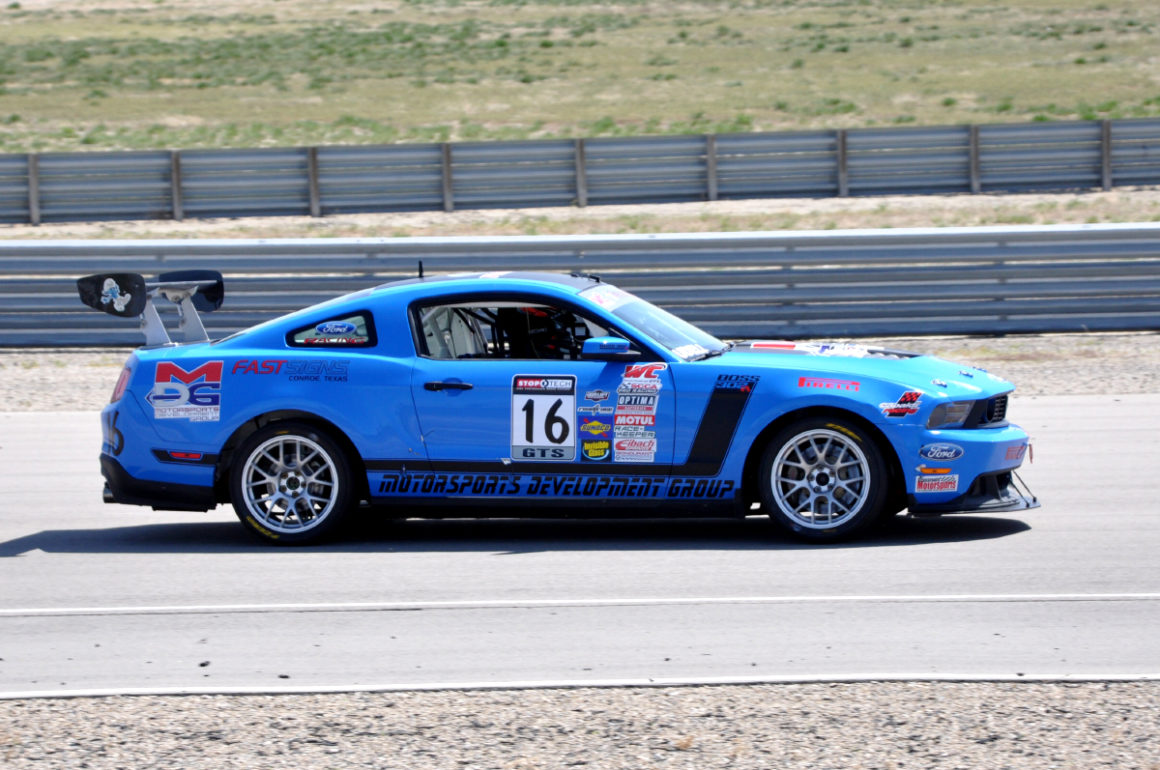
In GTS, just as the team had thought, the over-restricted Mustangs couldn’t even manage to stay in the lead pack. Still, Alec was tearing-up the track, eventually gaining twelve positions and only missing the Hard Charger award by one. Better yet, he passed championship leader, Justin Bell, and led him the entire race…with an engine from a stock Boss 302…that I helped put into the car. I couldn’t help but feel a bit proud.
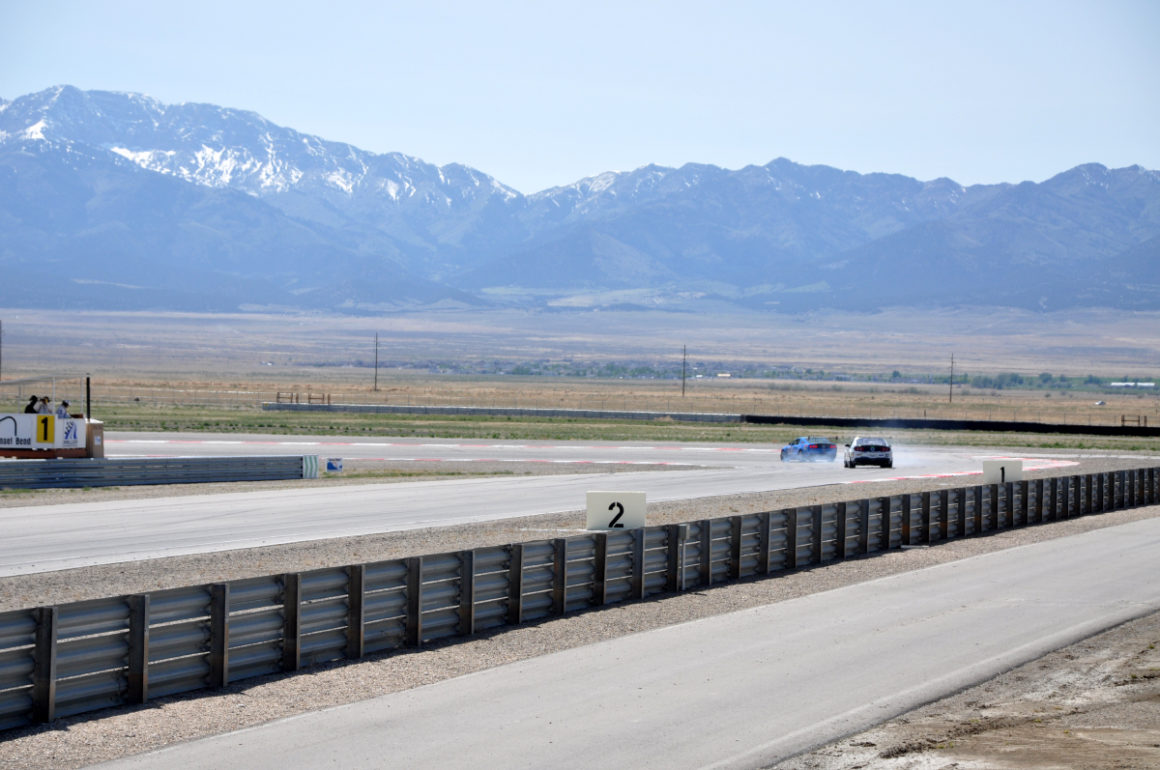
Alec might have done even better, but he lost his ABS early in the race. Here he is locking a rear wheel, while trying to stay ahead of Justin.
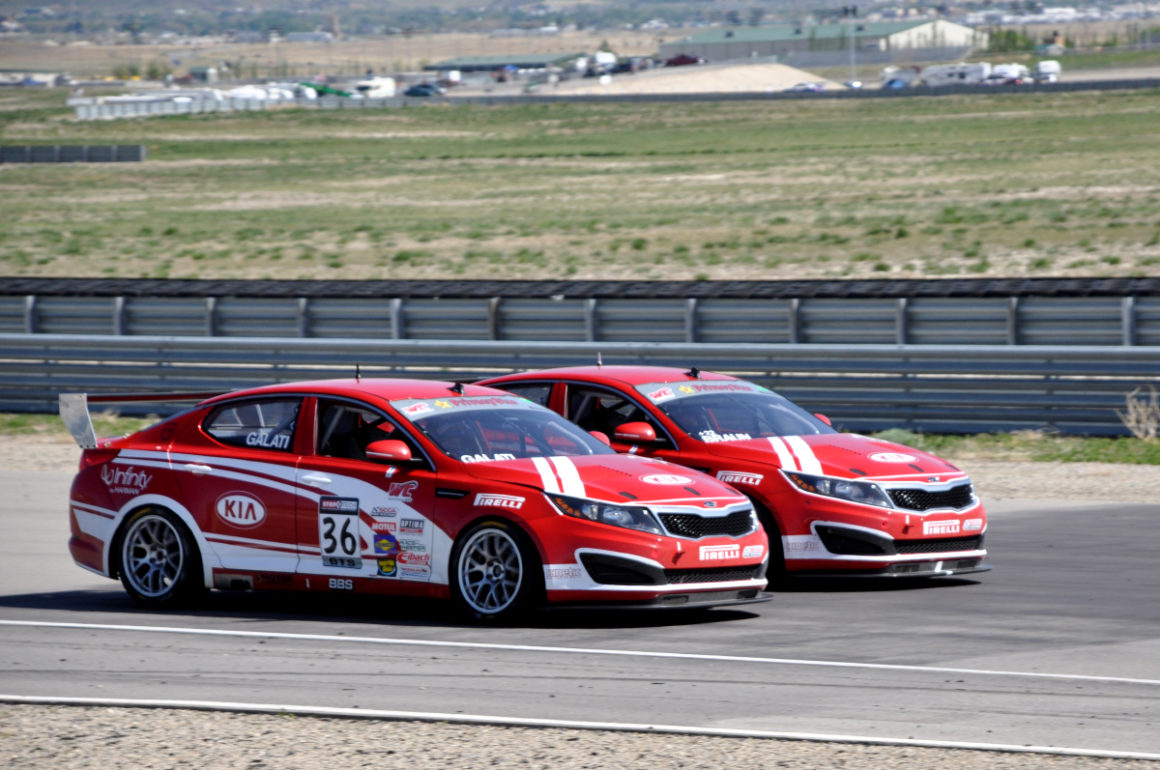
* SPOILER * The big news of the race was the two Kias (Michael Galati, Colin Braun) leading the race in GTS. They stood to place first and second, but less than two minutes after this photo was taken, on the last corner of the last lap, they collided and took each other off the podium, along with the leading Acura of Peter Cunningham! Andy Lee, sitting in fourth place with his Camaro, shot forward and took the checkered flag! Cue 007 theme.
You can watch the whole race on World Challenge TV here.
Immediately after the race, I helped get Stuart, Bob, and Alec to the airport for their flight back to Texas. I returned their rental Expedition back to the track and spent another hour or so having a beer and with Cody and Matt. I said goodbye to everyone and wished them luck at Laguna Seca. I wished I could join their traveling circus, but real life beckoned.
I got back on the road and made haste. This time, I drove through the night and only stopped for a couple of hours at a rest stop, just before sunrise and when the hallucinations were getting really bad. I took a different route back and found myself in a part of Texas that didn’t appear to be useful for anything other than slowing down travelers. But eventually, I made my way into Central Texas and the lovely roadside wildflowers in the hill country of home. In a life full of road trips and adventures, this had rated as one of the best of my life. I saw parts of America that I had never seen. I thought I would be alone, but I had made friends and had been invited into an experience that I thought I would only watch from the outside. It was beyond what I had hoped for and all because I bought a silly little car.

Appendix A – Fun Facts!
Total Miles: 3183
Avg. MPG: 22.5
Fuel: $566.16
Tickets: 0
Please pin, tweet, and share! Most importantly, let me know what you think in the comments below.
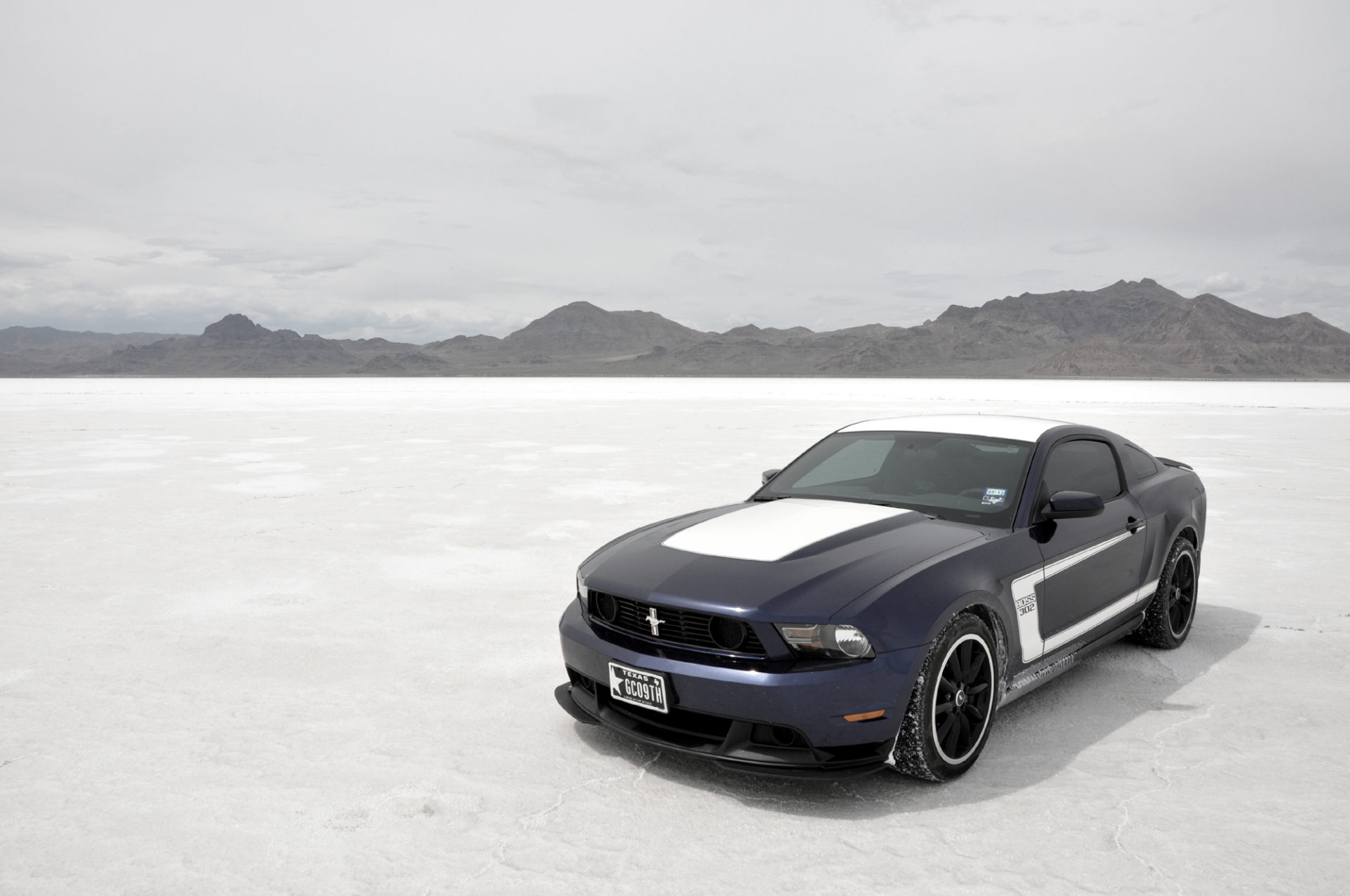
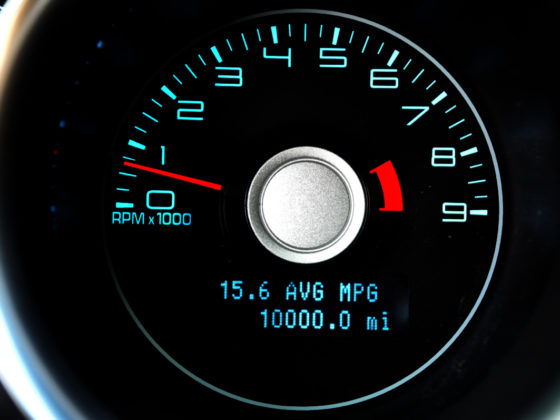









2 comments
Awesome post!
Just found your page. Great summary and photos of your Track Attack experience. Well late to your blog but would love to see more photos of the experience